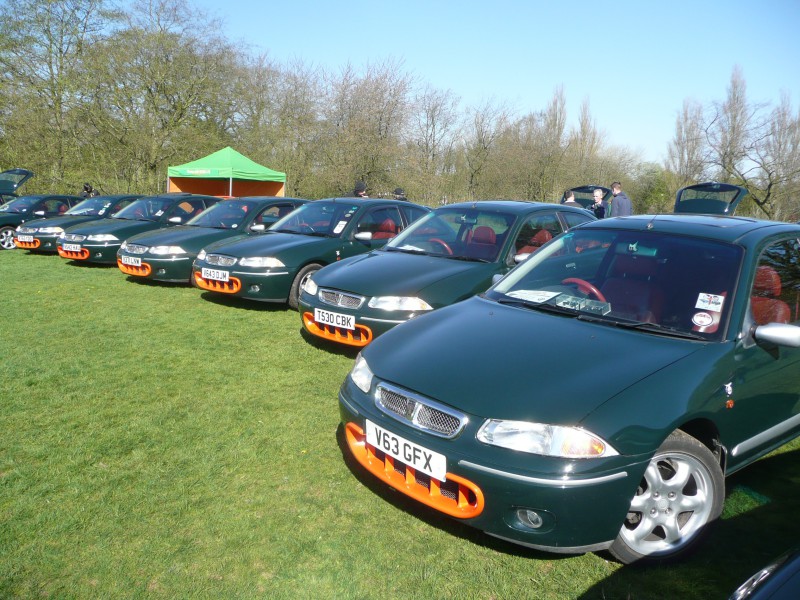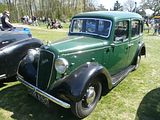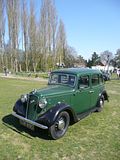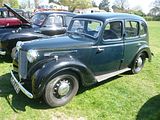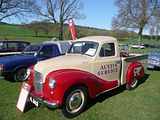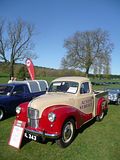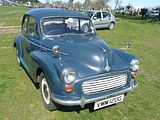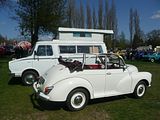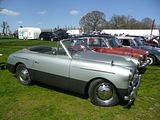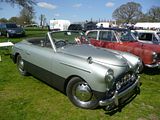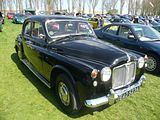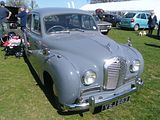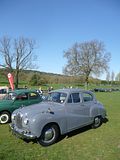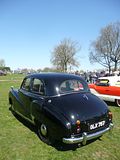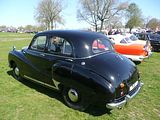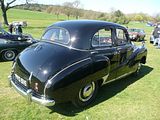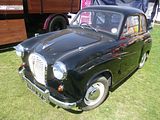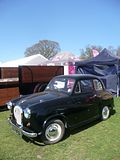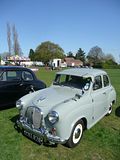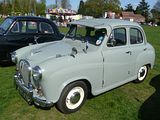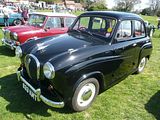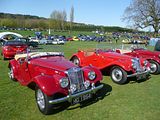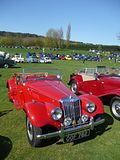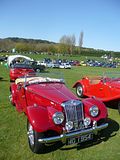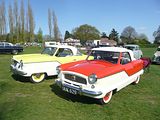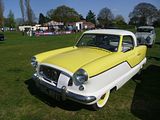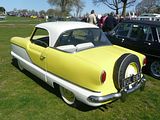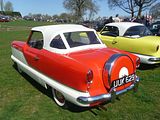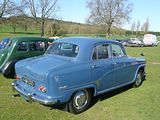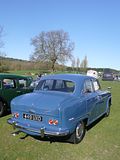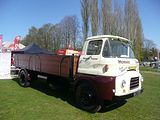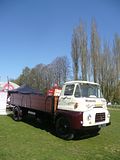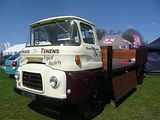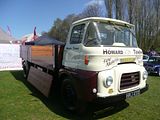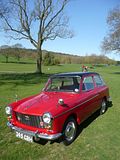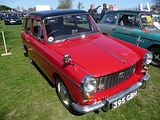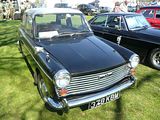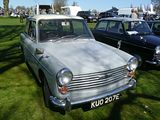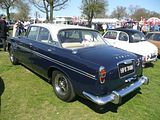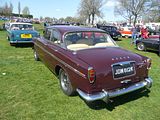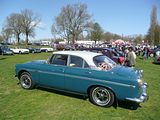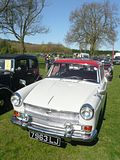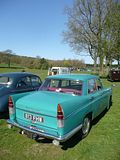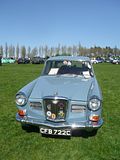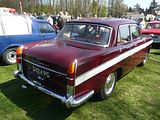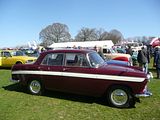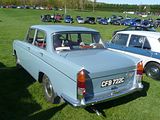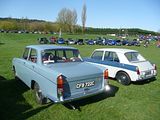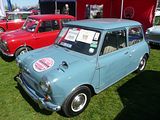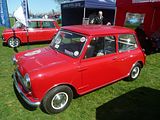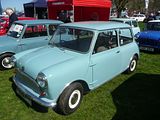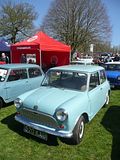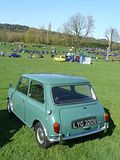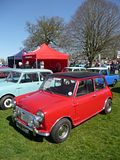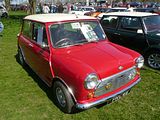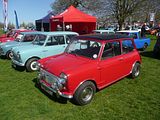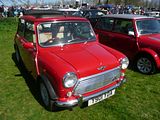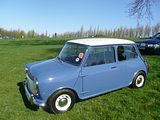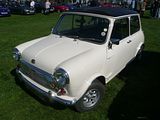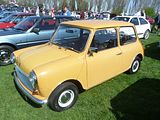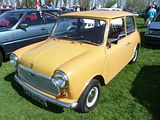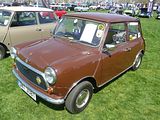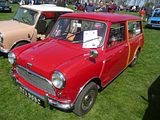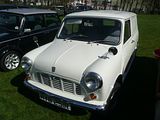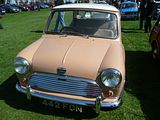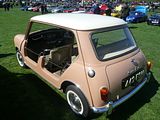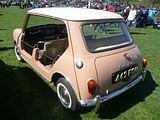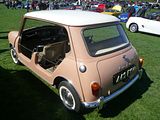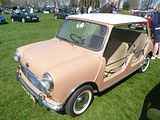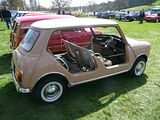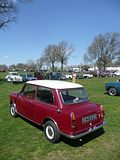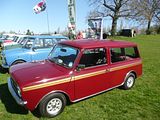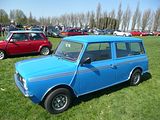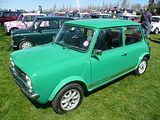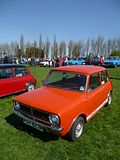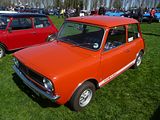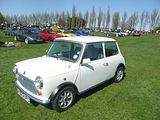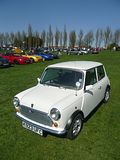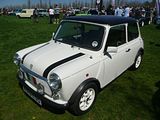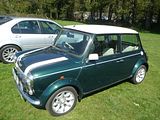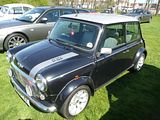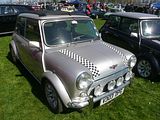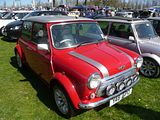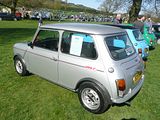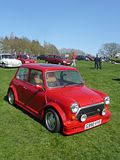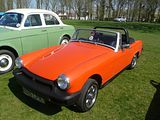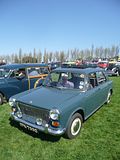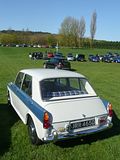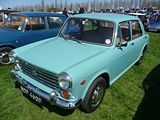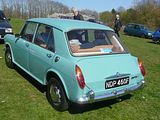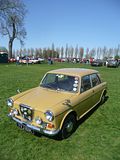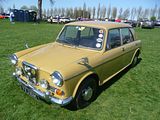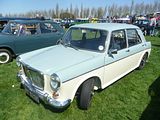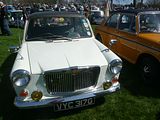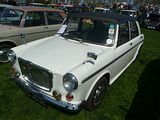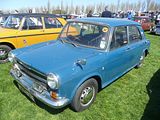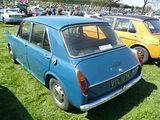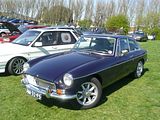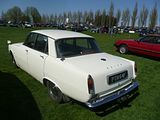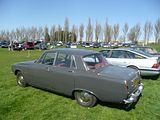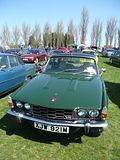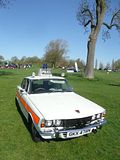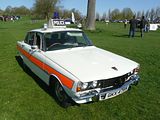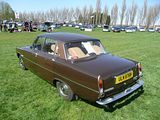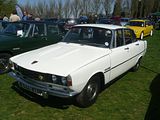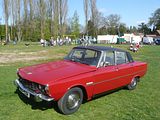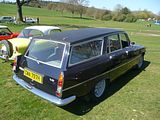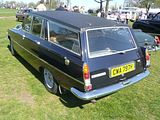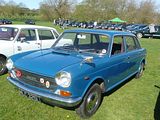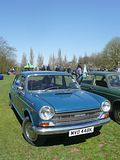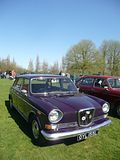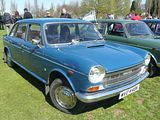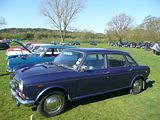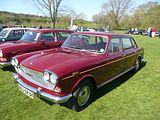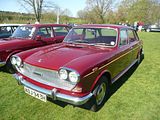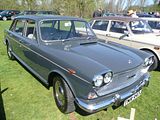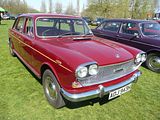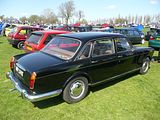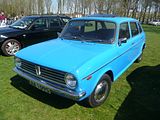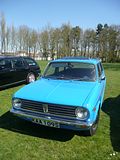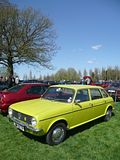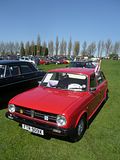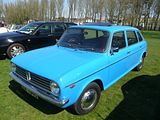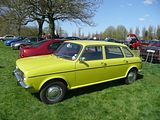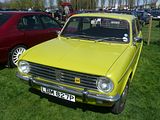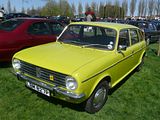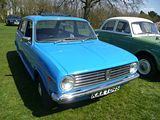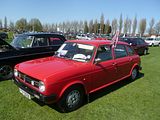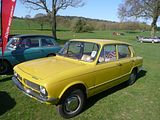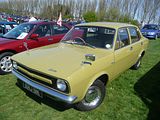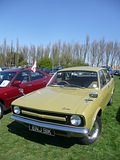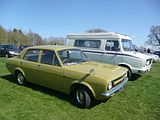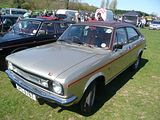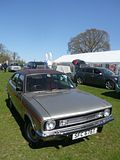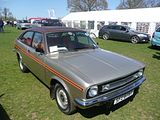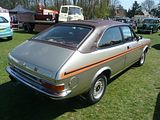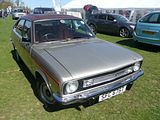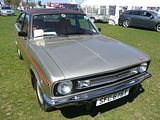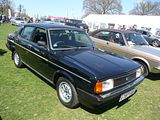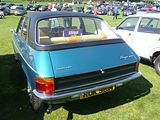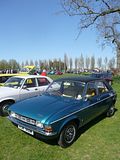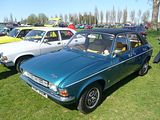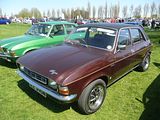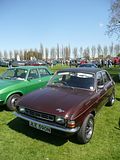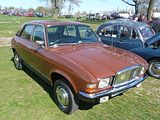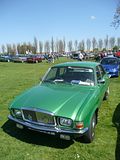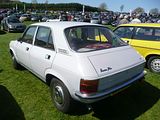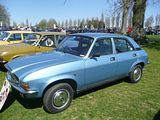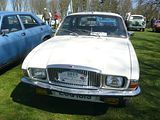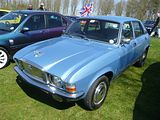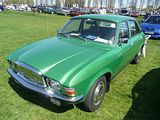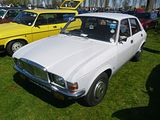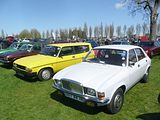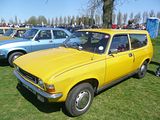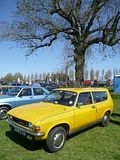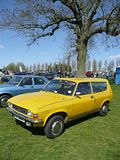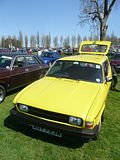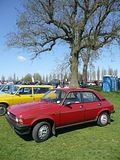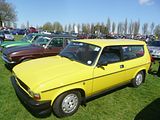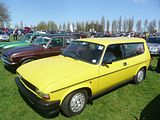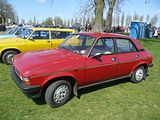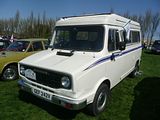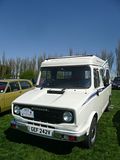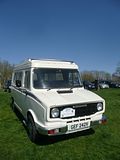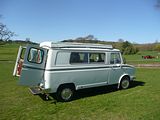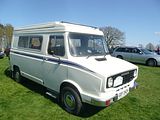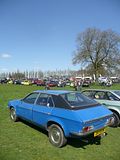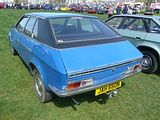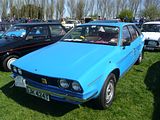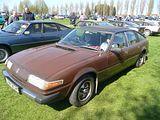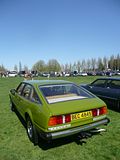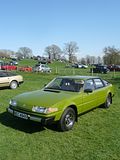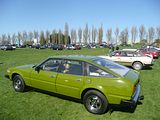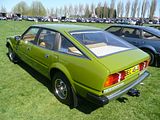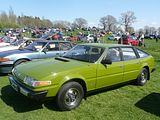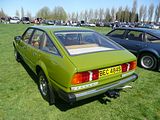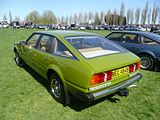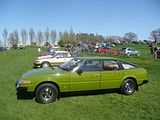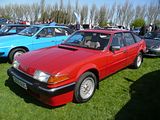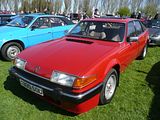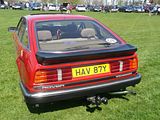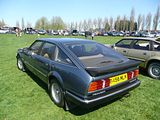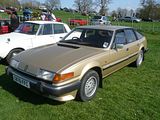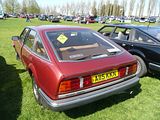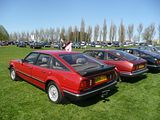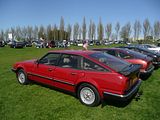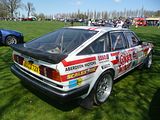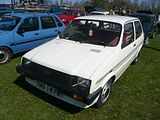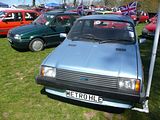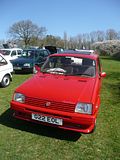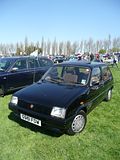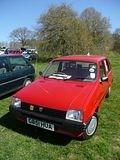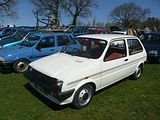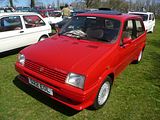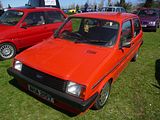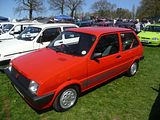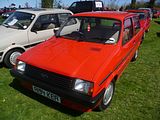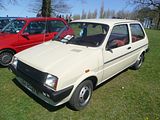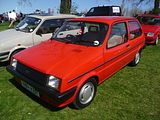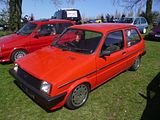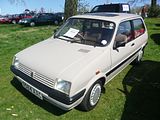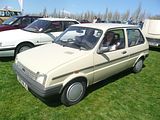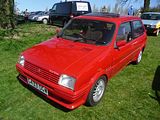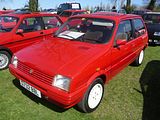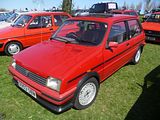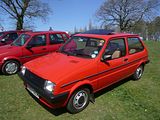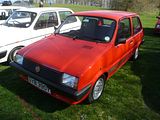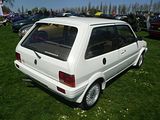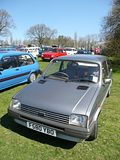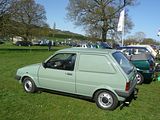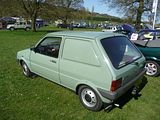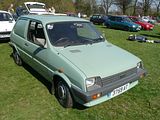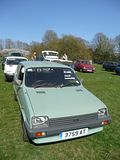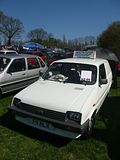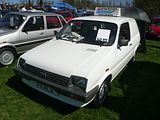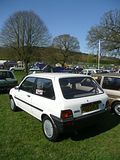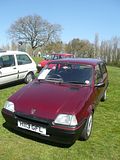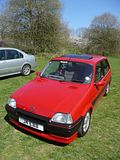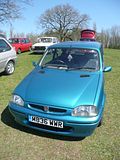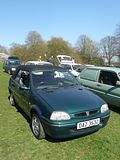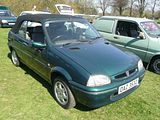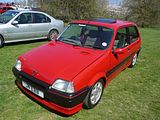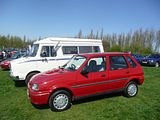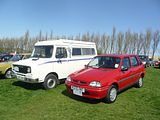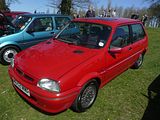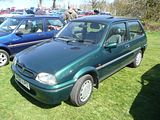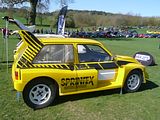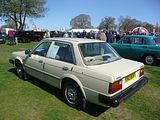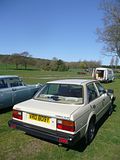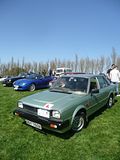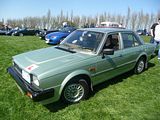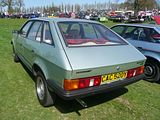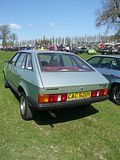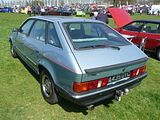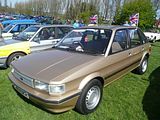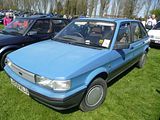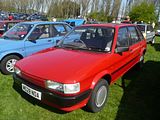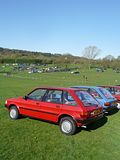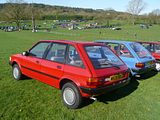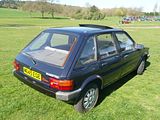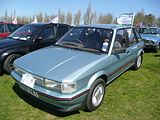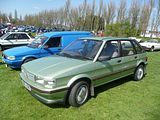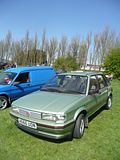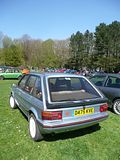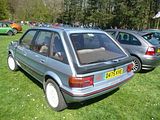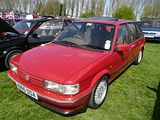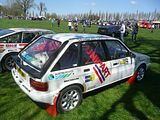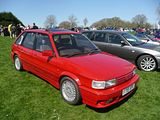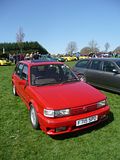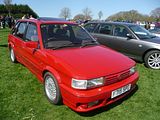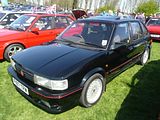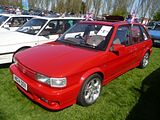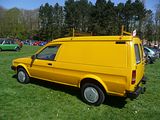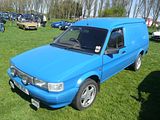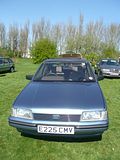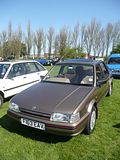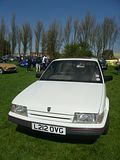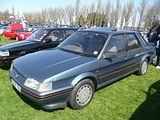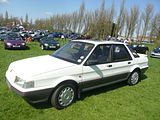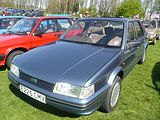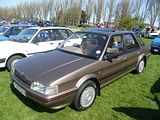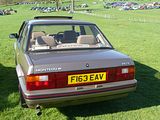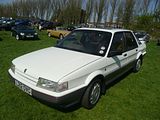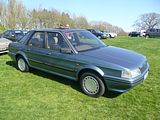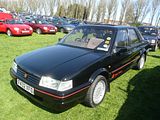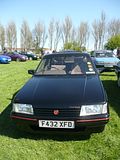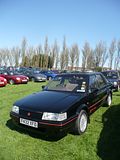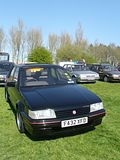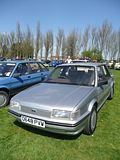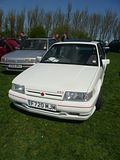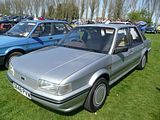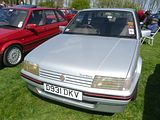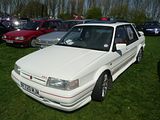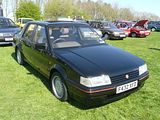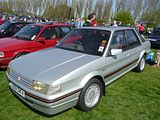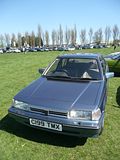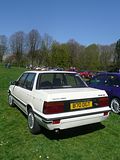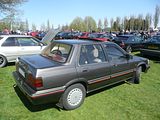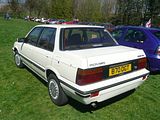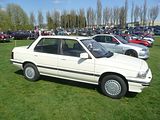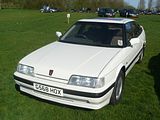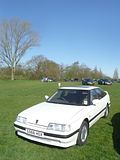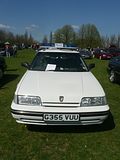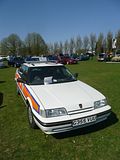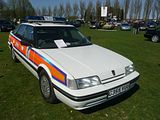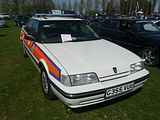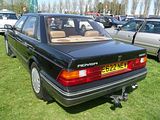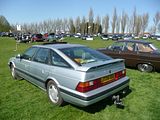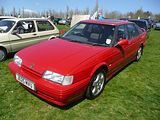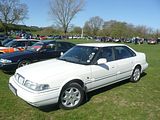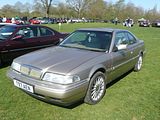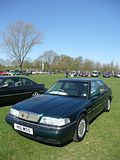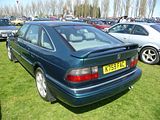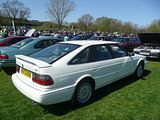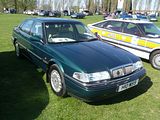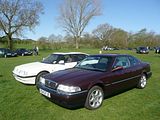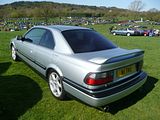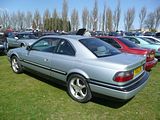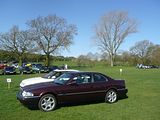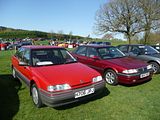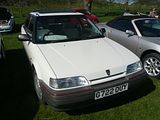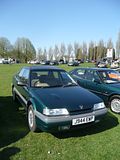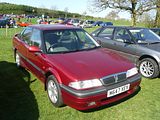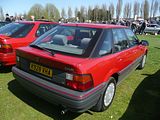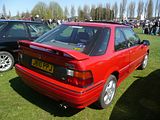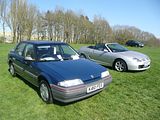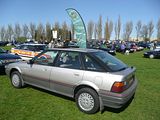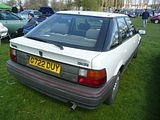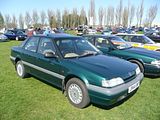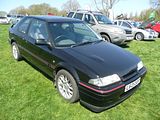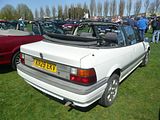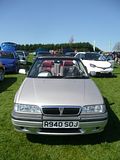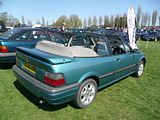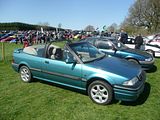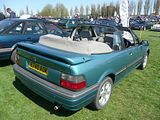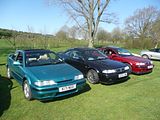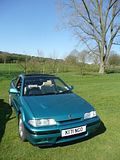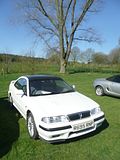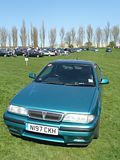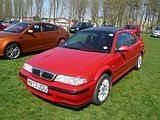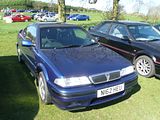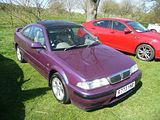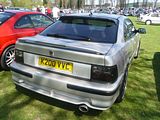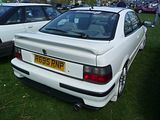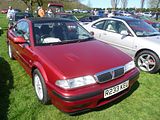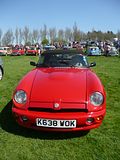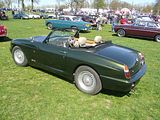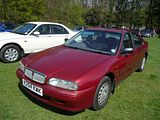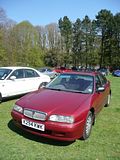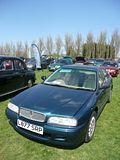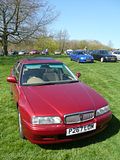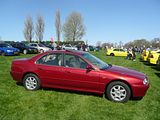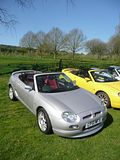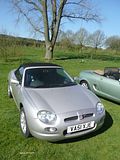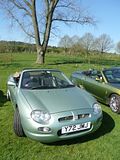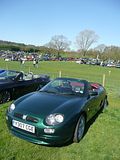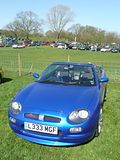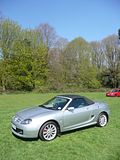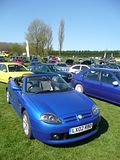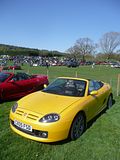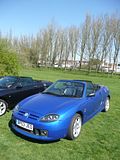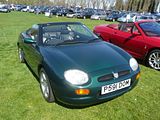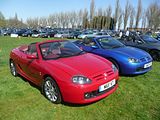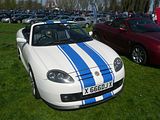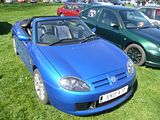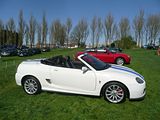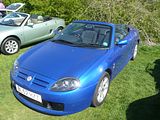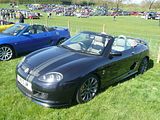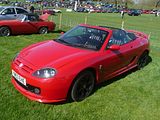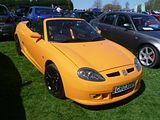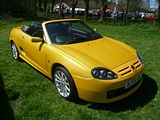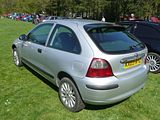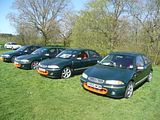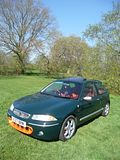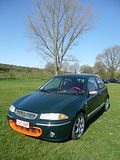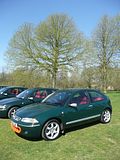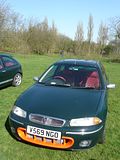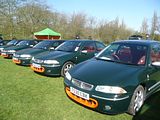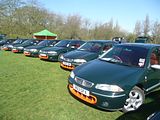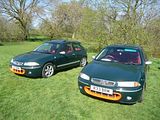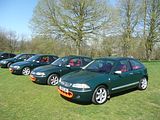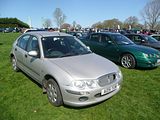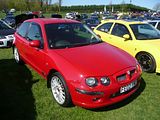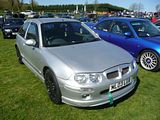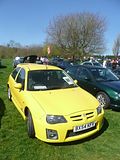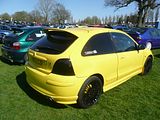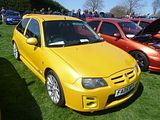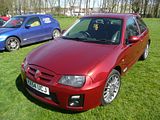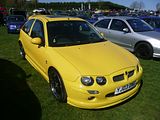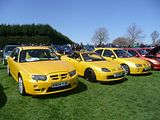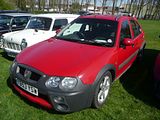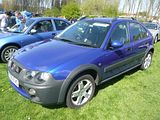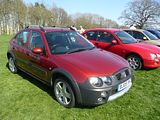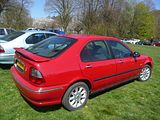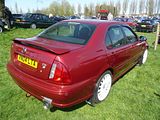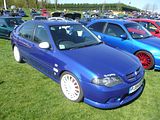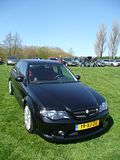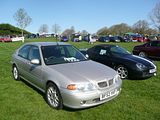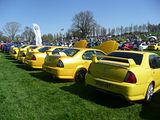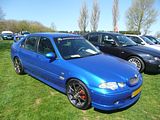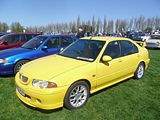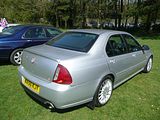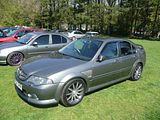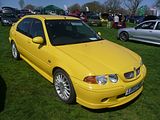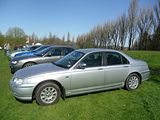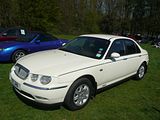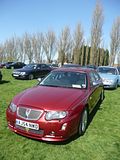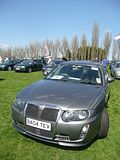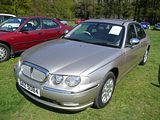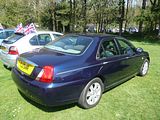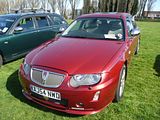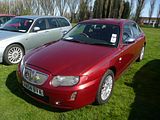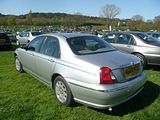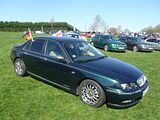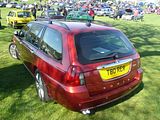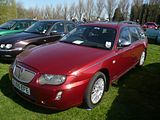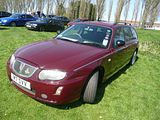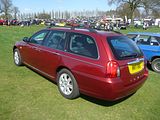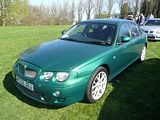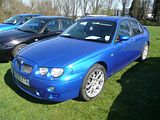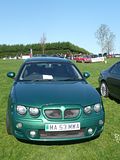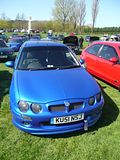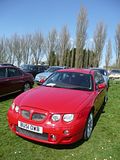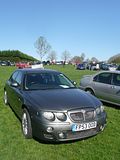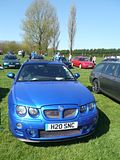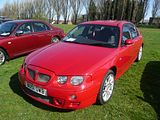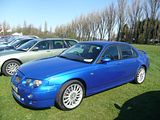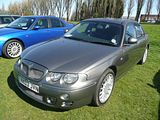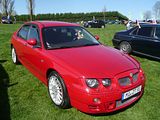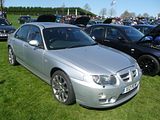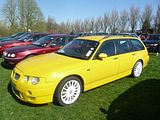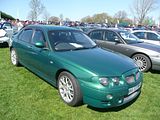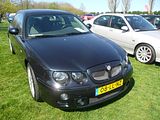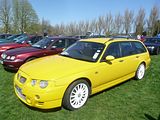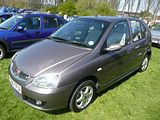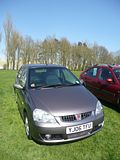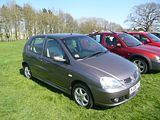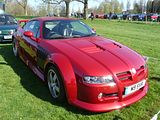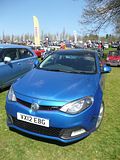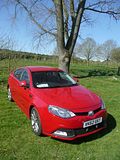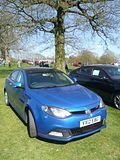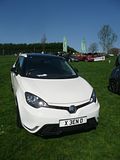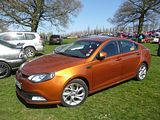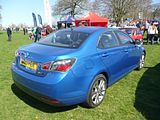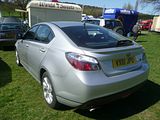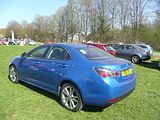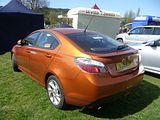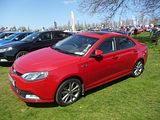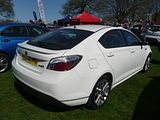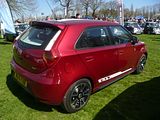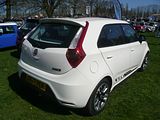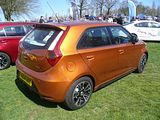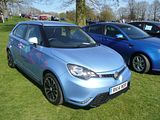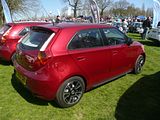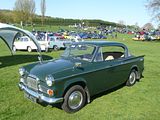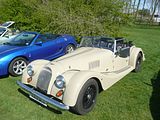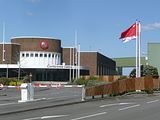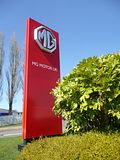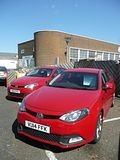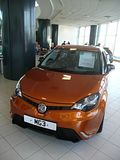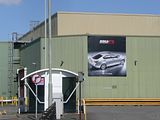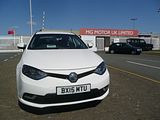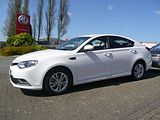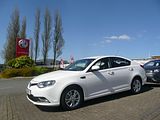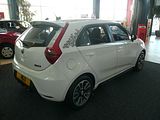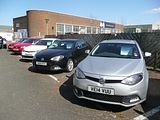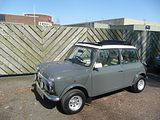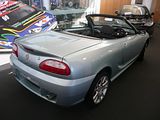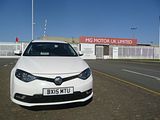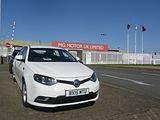The first Pride of Longbridge was held on the anniversary of the folding of the MG-Rover organisation. An almost spontaneous gathering of cars and owners, who assembled in Cofton Park, literally across the road from the old Longbridge works, the event proved so popular that it has become an annual tradition, timed to take place on the nearest weekend to the 15th April, that fateful day in 2005 when the end for an assembly of many once proud British marques came. Although the original scope was for cars with a close association with Longbridge, which for many years was home of “The Austin”, it quickly embraced all manner of models from the MG-Rover, Austin-Rover, BL Cars, British Leyland, BMC, and all their predecessors in title, with enthusiasts bringing examples of just about every model type that came from Longbridge, Cowley, Abingdon, Solihull and sometimes elsewhere. I first attended in 2012, and spent a day, as I guess did everyone else who went to the free-to-attend event, wallowing in nostalgia and having a history lesson on the British motor industry. Even rather chilly and damp weather did not deter the crowds in 2013 and 2014, and with 2015 representing the 10th anniversary of the closure, it was likely that it would prove to be the biggest gathering yet. Accordingly, a new organisation team was put in place, rather than relying on just one club to do all the hard work for all the other clubs to enjoy, and they clearly did a great job in contacting as many different groups of enthusiasts as possible, as when I looked at the website a few days before the event, there was a site map with vast number of different letters to indicate the location of the different clubs. With some of them geographic rather than model or marque specific, this did mean that some model types were spread out across the whole event. Whether you see that as a Good Thing or not, there can be no denying the fact that thanks, no doubt, to a lovely spring day with only a few clouds in early afternoon to interrupt the bright blue skies overheard, there was a massive turn out, and people stayed a lot longer than in previous years. I left at around 4:15pm, and there were still plenty of cars on site, whereas in previous years most people were gone by not long after lunch.
There were examples of just about every model type made by the companies which at some point in their history became part of the British Leyland empire here. Not surprisingly, there were far more of the MG-Rover cars present, a fact which some would decry, but the reality is that even though these are all now at least 10 years old, there are simply more of them that have survived than earlier models, and they are – despite what all the rumours and jokes might suggest – far more capable of driving longer distances reliably.
AUSTIN SEVEN
There were very few pre-war models at the event this time, which is a surprise, as when I have attended in the past, there have been significant numbers of older Austins, but this time, just three (and one car that although made after the war was based on a pre war design) were present. Two of these were Austin Seven models, and both were vans. Commercial vehicles tend to have a much harder life than passenger cars, so their survival rates are much lower, but these two were here to show what the small businessman or tradesman would have used to conduct their business around 80 years ago. The two models here date from 1938 and 1939.
AUSTIN TEN
Oldest passenger car, and indeed the oldest vehicle of the event was this 1937 Austin Ten. Austin had first launched the Ten in 1932, plugging the gap between the diminutive Seven and the larger Twelve models in their range which had been updated in early 1931. The Ten became the best seller in the range and was produced, in a number of different version through to 1947. A number of improvements were made to the car in the months following launch, but it was for 1937 when the first really big change came about with the launch of the almost streamlined Cambridge saloon and Conway cabriolet. Compared with the preceding cars, the passengers and engine were positioned much further forward, the back seat now being rather forward of the back axle. There were six side windows like the Sherborne and the quarter lights were fixed. Again like the Sherborne the forward doors opened rearwards. At the back there was now a compartment large enough to take a trunk as well as more luggage on the open compartment door when it was let down. A new smoother single plate spring-drive clutch was now fitted, the two friction rings carried by the centre plate were held apart by leaf springs. Other changes included Girling brakes with wedge and roller shoe expansion and balance lever compensation using operating rods in tension with automatic compensation between front and rear brakes all four of which might be applied by hand or foot. Drums were now 9 inches diameter. 16-inch steel disc wheels replaced the 18-inch wires Top speed from the 1141cc engine rose to 60 miles per hour. The car seen here dates from 1937.
A virtually new Ten was launched in May 1939, with the body shell incorporating the floor to give a semi-unitary structure. The car was completely restyled by Argentine born Dick Burzi who had joined Austin from Lancia in 1929. The bonnet was hinged at the rear, replacing the side-opening type on the old car and the radiator grille became rounded and there was no cabriolet. It was now available as four-door saloon with fixed or sliding head or as a sporting type four-seated tourer. The new chassis consisted of a platform braced with box members bounded by reversed U channelling the full length of each side. The body was then bolted, not welded, alternately to the top and bottom of that channelling. The forward end was strengthened by diagonal bracing and the centre given extra strength by the tunnel over the transmission. Windows were of toughened glass. The cylinder head was now aluminium for high compression and output now 32 bhp at 4,000 rpm. Shock absorbers were now hydraulic and of the double acting piston type. Bumpers were now given over-riders, lighting was 12-volt. Despite the outbreak of World War II, production of the Ten continued in large numbers; there were no tourers but there was a pick-up. In all during the war, 53,000 of the saloons and utilities—pick-ups and vans—the last two unofficially known as “Tillies”, were made. With peace in 1945 a change was immediately made to civilian production but because of the post-war financial crisis the cars were nearly all exported, with the first one arriving in the United States in July 1945. In September 1945 the first passenger cars produced after World War II’s end to arrive in Switzerland were two Austin Tens exported from England. The car continued in production in saloon form only until October 1947 to be replaced by the A40. The version seen here dates from 1946.
AUSTIN A40 DEVON
The first all new product from Austin after the war was the A40, which was launched in 1947, as the Dorset (a two door) and Devon (four door saloon). Taking some of their componentry from the pre-war Austin Eight, there was much that was all new in these cars, and sales of the Devon were strong, mostly in export markets. A range of light commercial versions were offered as well, the GV2 Panel Van, GQU2 Pickup and GK Countryman Estate car. The very early GV2 vans, introduced soon after the Devon and the Dorset were obviously based on the saloon, but in fact shared only some parts with it. The doors were the same pressings, although had different interior and exterior trim. The front end panelwork was derived from the saloon, although the front wings had larger apertures to accommodate the 17″ van wheels. The wheels were also much sturdier in design when compared to the 16″ rims fitted to the saloon. The rear bodywork was formed in aluminium, and there was a fabric centre panel in the roof. Removable rear spats covered the rear wheels, a feature shared with the pickup and van-based Countryman estate car. The grille was the mazak/chrome item found on the saloon, and the chassis and running gear, with its hydra-mechanical braking arrangement, were also shared (albeit with revised gear ratios). Early vans and cars had 5″ headlamps, but this would soon switch to Lucas 7″ units, and separate sidelights. At first glance, the A40 van seemed to change little throughout its production, a run that continued long after the contemporary Devon and Somerset saloons ceased, but in detail barely a year went by without some change being introduced by BMC, to improve the van and maintain its competitiveness. It was early in 1951 when the first batch of obvious changes were made. Most evident was a switch to a new grille assembly, painted instead of chrome. Early vans had smooth bonnets, although due to issues with cooling, extra vents were soon let in to the leading edge of the bonnet. By now the rear bodywork was in steel, including the roof panel, but still featuring separate aluminium rear wheel spats. The switch from the Devon-style dashboard to a simpler painted dash also occurred at around this time. These vans were known as the GV3 series. Late in 1951 the Devon saloon underwent a number of revisions, including a switch to a column gearchange, and hydraulic braking to all four wheels. The 17″ wheels were modified slightly, to accommodate wider brake drums, meaning that wheels for earlier vans are not interchangeable with later examples. The revised GV4 commercials followed many of the changes introduced to the saloon, in preparation for the introduction of the Somerset-type running gear due in 1952. This would be the year that the A40 Devon saloon was replaced, yet the light commercials remained in production, alongside the Somerset saloon, for many years to come. By 1953 the A40’s rear bodywork would see another update, this time integrating the rear arches into the main body of the vehicle, at the same time improving access for wheel changing. The final GV5 series van, introduced in September 1954, continued in production, alongside the new A40/A50 Cambridges, right up to 1957, meaning that the A40 vans stayed in production for ten years. Over 78,000 vans were produced, as well as 61,800 pickups and 26,500 Countryman estates. As with all light commercials, these 1/2 ton vans usually got a real hammering in the hands of the many different tradesmen that bought the 10cwt Austin van. As a result, survivors are distinctly rare on the ground, so it was nice to see this well presented example of the PickUp.
MORRIS MINOR
When launched, in 1948, the Morris Minor was very much the rival product to anything coming out of Longbridge. Although Morris and Austin merged in 1952, to create the British Motor Corporation, the car remained as in an in-house rival to those being produced by Austin, and were only sold by Morris dealers. The much loved Minor is one of Britain’s best loved classics, certainly of the affordable sort, but there were only 2 of them were, a late model 1000 Saloon and the open=topped Tourer, perhaps reflecting the fact that the owners see these as Cowley cars and not Longbridge ones.
AUSTIN A40 SPORTS
Launched at the 1949 London Motor Show was the A40 Sports, a four-passenger, aluminium-bodied convertible version of the Austin A40 – carrying an Austin of England nameplate, bearing Austin’s Flying A hood ornament, and designed and manufactured in conjunction with Jensen Motors. Production did not begin until November 1950 for model year 1951. By the time production ended in 1953, about 4,011 examples had been produced. As one in a series of collaborations between Austin and Jensen Motors of West Bromwich, the A40 Sports originated when Austin’s chairman Leonard Lord saw the Jensen Interceptor and requested that Jensen develop a body that could use the A40 mechanicals. The resulting body-on-frame A40 Sports was designed by Eric Neale, a stylist who had joined Jensen in 1946 after working at Wolseley Motors. During production, A40 Sports bodies were built by Jensen and transported to Austin’s Longbridge plant for final assembly. As per Lord’s intention, the A40 Sports was based on the mechanicals of the Austin A40 Devon, though the centre section of the chassis was boxed to provide rigidity for the open body. The A40 Sports also employed a twin-SU carburettor version of the 1.2 litre engine producing 46 bhp rather than 42 bhp Gear selection was originally via a floor-mounted lever. Steering was worm and roller type, front suspension was independent coil springs with rigid beam axle and semi-elliptic leaf springs at the rear. Production of the A40 Sports occurred in two series. The initial GD2 Series began in November 1950 and featured a floor gear change and dashboard identical to that of the Devon. The later GD3 Series began production in August 1951 and ended in April 1953, featuring a steering-column gear change, full hydraulic brakes, and a revised dash with a centred instrument panel The A40 Sports had trouble maintaining 60 to 65 miles per hour cruising speeds – despite a top speed of 77.8 mph as recorded by the British magazine The Motor in 1951 – and could accelerate from 0–60 mph in 25.6 seconds. Tests achieved a fuel consumption of 29.3 mpg. In the United States – initially targeted as its primary market – the A40 was priced at about $2,200. It was listed at about £818 in the UK,at a time when a mainstream middle market six-cylinder saloon, the Vauxhall Velox, was offered for £550 and Austin’s own A40 saloon was offered for slightly more than £500.
ROVER P4
Two examples of the P4, or “Auntie” Rover were here, an early “cyclops eye” 75 with its distinctive central third light and a late model 95. The P4 had a long production run, and thanks to its sturdy construction, survival rates are quite good, making them a popular classic these days. Like many manufacturers, when production resumed after the Second World War, Rover continued making the same cars as they had been producing before hostilities had broken out. The first new car that they announced was the P4 model, known as the 75. It was launched at the Earls Court Motor Show in September 1949, to replace all previous models and then continued in production until 1964, though the car underwent lots of change under the skin in those 15 years. Designed by Gordon Bashford, the car went into production in 1949 as the 6-cylinder 2.1-litre Rover 75. It featured unusual modern styling in stark contrast with the outdated Rover P3 model 75 which it replaced. Gone were the traditional radiator, separate headlamps and external running boards. In their place were a chromium grille, recessed headlamps and a streamlined body the whole width of the chassis. The car’s styling was derived from the then controversial 1947 Studebakers. The Rover executives purchased two such vehicles and fitted the body from one of them to a prototype P4 chassis to create a development mule. In James Taylor’s highly regarded book ‘Rover P4 – The Complete Story’ he advised that this vehicle was affectionately known as the ‘Roverbaker’ hybrid. Another, at the time minor, distinctive feature but this one did not catch-on was the centrally mounted light in the grille where most other manufacturers of good quality cars provided a pair, one fog and one driving light often separately mounted behind the bumper. Known, unkindly, as the “Cyclops eye” it was discontinued in the new grille announced 23 October 1952. The earliest cars used a more powerful version of the Rover engine from the 1948 Rover P3 75, a 2103 cc straight-6 engine now with chromium plated cylinder bores, an aluminium cylinder head with built-in induction manifold and a pair of horizontal instead of downdraught carburettors. A four-speed manual transmission was used with a column-mounted gear lever which was replaced by a floor-mounted mechanism in September 1953. At first the gearbox only had synchromesh on third and top but it was added to second gear as well in 1953. A freewheel clutch, a traditional Rover feature, was fitted to cars without overdrive until mid-1959, when it was removed from the specifications, shortly before the London Motor Show in October that year. The cars had a separate chassis with independent suspension by coil springs at the front and a live axle with half-elliptical leaf springs at the rear. The brakes on early cars were operated by a hybrid hydro-mechanical system but became fully hydraulic in 1950. Girling disc brakes replaced drums at the front from October 1959. The complete body shells were made by the Pressed Steel company and featured aluminium/magnesium alloy (Birmabright) doors, boot lid and bonnets until the final 95/110 models, which were all steel to reduce costs. The P4 series was one of the last UK cars to incorporate rear-hinged “suicide” doors. After four years of the one model policy Rover returned to a range of the one car but three different sized engines when in September 1953 they announced a four-cylinder Rover 60 and a 2.6-litre Rover 90. A year later, an enlarged 2230cc engine was installed in the 75, and an updated body was shown with a larger boot and a bigger rear window and the end of the flapping trafficators, with redesigned light clusters. Further detailed changes would follow. Announced 16 October 1956, the 105R and 105S used a high-output, 8.5:1 compression version of the 2.6 litres engine used in the 90. The higher compression was to take advantage of the higher octane fuel that had become widely available. This twin-SU carburettor engine produced 108 hp. Both 105 models also featured the exterior changes of the rest of the range announced a month earlier. The 105S featured separate front seats, a cigar lighter, chromed wheel trim rings and twin Lucas SFT 576 spotlamps. To minimise the cost of the 105R, these additional items were not standard, however they were provided on the (higher priced) 105R De Luxe. The 105R featured a “Roverdrive” automatic transmission. This unit was designed and built by Rover and at the time was the only British-built automatic transmission. Others had bought in units from American manufacturers such as Borg-Warner. This unit was actually a two-speed automatic (Emergency Low which can be selected manually and Drive) with an overdrive unit for a total of three forward gears. The 105S made do with a manual transmission and Laycock de Normanville overdrive incorporating a kick-down control. The 105S could reach a top speed of 101 mph. Production of the 105 line ended in 1958 for the 105R and 1959 for the manual transmission 105S, 10,781 had been produced, two-thirds with the manual transmission option. For 1959 the manual model was described simply as a 105 and the trim and accessory level was reduced to match the other models.In 1959, the engines were upgraded again, with the 80 replacing the 60 and the 100 replacing the 90 and the 105. The four cylinder cars were not particularly popular, though and in September they were replaced by the six cylinder 95. Final model was the 110, seen here, which took its place at the top of the range until production ceased, a few months after the very different P6 model 2000 had come along.
AUSTIN A40 SOMERSET
The first A40 was replaced in 1952 by the next car to take its name from one of the Counties of England, the Somerset. Only made between 1952 until 1954, this car looked bigger than the Devon, though that was largely an illusion of the new appearance which was somewhat “Transatlantic” in style with flowing lines which was designed for export. It bore a close resemblance with the larger Austin A70 Hereford, and telling the two apart at glance is no easier than some of today’s car where people think that the same styling went under the “reduce” or “enlarge” buttons! The Somerset shared a number of components with its earlier sibling which included a similar 1.2 litre straight-4 pushrod B series engine, but updated to produce 42 hp, compared to the Devon’s 40 hp, giving the car a top speed of 69 mph. Stopping it was done with hydraulic brakes. The Austin A40 Somerset’s reputation for being somewhat slow and lumbering to drive is not wholly deserved. The vehicle had to endure poor quality petrol supplies and in consequence had retarded ignition settings to tolerate the low octane rating of this poor fuel grade to avoid the ‘pinking’ condition that was well known in those times. In fact BMC later produced a kit to improve the performance and fuel consumption of these cars once premium fuel supplies resumed under the popular petrol brands. This kit comprised a replacement distributor and an optional head gasket for the cylinder head that was thinner and therefore raised the compression slightly from the standard 7.2:1. An Autocar magazine road test published 18 April 1952 achieved a maximum of 66 mph and a 0-60 mph acceleration of 36.6 seconds whereas the example registered new in February 1954 and given a Used Car Test published in the Autocar series dated 8 April 1960 returned a 0-60 mph time of just 27.9 seconds. The standing quarter mile was down from 24.4 secs to 23.2 secs a marked improvement on the former result taken in 1952 and directly comparable with the Mini 850 launched in 1959, that was considered to be fairly brisk then. There were two close fitting front seats which could be arranged as a bench seat, with space freed up by virtue of the four speed column mounted gear change. The Somerset was initially offered only as a 4-door saloon, with a 3-passenger 2-door convertible, of the same body shape, introduced in late 1952. The body for the convertible was made by Carbodies of Coventry and the model was marketed as the Austin A40 Somerset Coupé. The convertible differed from the saloon in having separate front seats that folded forward to give access to the rear. The Austin Motor Company in 1953 made a “special” version of around 500 Somerset saloons with a more powerful engine, different interior appointments and two-tone paintwork. The Austin Somerset Special had a top speed of 74 mph. Over 173,000 were sold before the Somerset was replaced by the A40 Cambridge in 1954. 7243 of them were convertibles.
AUSTIN A70 HEREFORD
Austin had offered a 6 cylinder version of the Devon/Dorset, called the A70 Hampshire, though it was short lived and you rarely see those cars these days. The A70 Hereford replaced the Hampshire in 1950 and was wider and slightly longer with an extra 3 inches in the wheelbase. The car retained the 2199cc 4-cylinder engine first seen officially in 1945 on the Austin 16. Performance was adequate by the standards of the time, but the car was not particularly quiet, and an Autocar magazine road test in 1950 reported a “small vibration at about 40 m.p.h. on the overrun” on their test car. Austin had given a lead after the war in equipping their cars with interior heaters at no extra cost, and the Hereford came fitted with “the latest Smiths fresh-air installation” as standard equipment. The road tester found the heater, like the engine and indeed the windscreen wipers, “rather noisy in operation”, however. An A70 tested by The Motor in 1951 had a top speed of 80.5 mph and could accelerate from 0-60 mph in 21.4 seconds. A fuel consumption of 21.9 mpg was recorded. The test car cost £911 including taxes. A new addition to the range was the A70 Coupe, a 2-door convertible with coachwork by Carbodies of Coventry. A notable mechanical change was the use of hydraulic brakes. The smaller A40 Somerset had similar styling and even shared the same door panels. A rare variant was a pickup, marketed as the A70 Pick-up. This shared the same platform as the estate, but with fully faired bodywork aft of the driving cab. The interior of this rather plush workhorse was the same as the saloon, with a large split-bench seat, and full instrumentation set in the middle for easy completion whether for left- or right-hand drive. Sales were slow, with 50,421 having been produced when the A90 Westminster replaced it in 1954.
AUSTIN A30/35
The Morris Minor was already well established when rival Austin launched their competitor, the A30 Saloon of 1952. That was also the year that Austin and Morris merged to become the British Motor Corporation, so suddenly the two cars that had been conceived to compete against each other were stablemates. Except BMC did not work like that. Separate dealer chains remained in place, as they would do for a further 30 years, and whilst this may sound inefficient now, it has to be noted that brand loyalty was such that there were plenty of people would only consider an Austin say, and not a Morris, or vice versa. The A30 was smaller than the Minor and at £507, at launch, it was also £60 cheaper. The body structure was designed by T.K. Garrett, who had been an aeronautical engineer before joining Austin. It was of fully stressed monocoque chassis-less construction, which made it lighter and stiffer than most contemporary vehicles, the first Austin to be made in this way. Inside there were individual seats at the front and a bench at the rear covered in PVC with an option of leather facings on the seats. Evidence of economy was seen in only having a single windscreen wiper, central combined stop/tail/numberplate lamp and a sun visor in front of the driver only. A passenger-side wiper and sun visor, and a heater were available as optional extras. Even so, it sold well, and 223,264 examples were built. The A30 was replaced by the Austin A35 in 1956 with the new name reflecting the larger and more powerful 34 hp A-Series engine, which gave the car a slightly higher top speed and better acceleration, though much of this came as a result of different gearbox ratios. The A30 had the first three ratios close together then a big gap to top, whereas in the A35, the ratios were better spaced and gave a higher speed in third gear. That top speed was 72 mph and 0 – 60 acceleration times are just over 30 seconds, so this remains a very slow car by modern standards. The A35 was very similar in appearance to the A30, and is best recognised by its larger rear window aperture and a painted front grille, with chrome horse-shoe surround, instead of the chrome grille featured on the A30. The semaphore trafficators were replaced with present-day front- and rear-mounted flashing light indicatorss. A slightly easier to operate remote-control gear-change was provided. Like the A30, the A35 was offered as a two- or four-door saloon, two-door “Countryman” estate and also as a van. The latter model continued in production through to 1968. A rare coupe utility (pickup) version was also produced in 1956, with just 477 sold. Drawings were made for a sports tourer, but no prototype was actually built. The A35 passenger cars were replaced by the new body shape A40 Farina models in 1959 but the estate car version continued until 1962 and van until 1968. These days they are popular as an affordable classic. Their simple mechanicals, good availability of some parts (not bodywork, though) and pert looks give them widespread appeal. There were several examples of the model here, all of them A35s.
MG TF
Final version of the popular T Series sports car was the TF, launched on the 15 October 1953. Although it looked quite a bit different, this was really just a facelifted TD, fitted with the TD Mark II engine, headlights faired into the wings, a sloping radiator grille concealing a separate radiator, and a new pressurised cooling system along with a simulated external radiator cap. This XPAG engine’s compression ratio had been increased to 8.1:1 and extra-large valves with stronger valve springs and larger carburettors increased output to 57.5 bhp at 5,500 rpm. In mid-1954 the engine capacity was increased by 17 per cent to 1466 cc and designated XPEG. The bore was increased to 72 mm and compression raised to 8.3:1 giving 63 bhp t 5,000 rpm and a 17 per cent increase in torque. The car was now designated TF1500, and externally distinguished by a cream background enamel nameplate on both sides of the bonnet, placed just to the rear of the forward bonnet-release buttons. Production ended at chassis number TF10100 on 4 April 1955 after 9,602 TFs had been manufactured, including two prototypes and 3,400 TF1500s. The TF was superceded by the MGA. A number of replica models have been built in more recent years, with the Naylor of the mid 1980s being perhaps the best known.
METROPOLITAN
Among the most colourful of all the cars on offer, certainly for their period, were the Metropolitans, a number of which were on show here. Designed in the U.S. and patterned from a concept car, the NXI (Nash Experimental International), that was built by Detroit-based independent designer William J. Flajole for Nash-Kelvinator, this was designed as the second car in a two car family, for “Mom taking the kids to school or shopping or for Dad to drive to the railroad station to ride to work”. This “commuter/shopping car” bore a resemblance to the big Nash models of the era, but the scale was tiny as the Met’s wheelbase was shorter than a Volkswagen Beetle’s. The NXI design study had incorporated many innovative features, and attempted to make use of interchangeable front and rear components (the symmetrical door skins were the only interchangeable items that made it into production). Although more complex, the new vehicle also incorporated Nash’s advanced single-unit monocoque construction. It had been displayed at a number of “surviews” (survey/previews), commencing on 4 January 1950 at the Waldorf-Astoria Hotel, New York, to gauge the reaction of the American motoring public to a car of this size, the results of which convinced Nash that there was indeed a market for such a car, if it could be built at a competitive price. A series of prototypes followed that incorporated many of the improvements requested, including roll-up glass side windows, a more powerful engine, and a column-mounted gearlever with bench seat (rather than bucket-type seats with floor change of the concept car). The model was named NKI (for Nash-Kelvinator International), and it featured revised styling incorporating a hood blister and rear wheel cutouts. Nash was positioning this new product for the emerging postwar market for “personal use” autos, and also saw it as a means of Nash to overseas markets. However, Mason and Nash management calculated that it would not be viable to build such a car from scratch in the U.S. because the tooling costs would have been prohibitive. The only cost-effective option was to build overseas using existing mechanical components (engine, transmission, rear end, suspension, brakes, electrical), leaving only the tooling cost for body panels and other unique components. Nash Motors negotiated with several European companies, and on October 5, 1952, announced that they had selected the Austin Motor Company (by then part of BMC) and Fisher & Ludlow (which also became part of BMC in September 1953, later operating under the name Pressed Steel Fisher), both based in Birmingham and vicinity. Fisher & Ludlow would produce the bodywork, while the mechanicals would be provided, as well as final assembly undertaken, by the Austin Motor Company. This was the first time an American-designed car, to be exclusively marketed in North America, had been entirely built in Europe. It became a captive import – a foreign-built vehicle sold and serviced by Nash (and later by American Motors) through its dealer distribution system. It is believed that the first pre-production prototype was completed by Austin on December 2, 1952. In all, five pre-production prototypes were built by Austin Motors and tested prior to the start of production. The total tooling cost amounted to US$1,018,475.94, which was a fraction of the tooling cost for a totally U.S.-built vehicle. The styling for all Nash vehicles at that time was an amalgam of designs from Pininfarina of Italy and the in-house Nash design team. The different models from Ambassador down to the Metropolitan utilised very similar design features (fully enclosed front wheels, notched “pillow” style door pressing, bar style grille etc.). Whilst Nash used the fact that styling was by Pininfarina in their advertising for their larger models, Pininfarina refused to allow his name to be associated with the Metropolitan as he felt it would damage his reputation with other Italian car companies to be linked to such a small car. The new Metropolitan was made in two body designs: convertible and hardtop. All came with several standard features that were optional on most cars of the era. Among these factory-installed benefits for customers were a map light, electric wipers, a cigar lighter, and even a “continental-type” rear-mounted spare tyre with cover. To give a “luxury” image to the interior, “Bedford cord” upholstery trimmed with leather was used (similar to larger Nash vehicles). An AM radio, “Weather Eye” heater, and whitewall tyres were offered as optional extras for the U.S. market. (It is unlikely that a Metropolitan could have been purchased without a heater and radio, as all vehicles left the factory with both items fitted.) The cars were small, with an 85 in wheelbase, an overall length of just 149.5 in and a gross weight of only 1,785 lb for the Convertible and 1,825 lb for the Hardtop, thus making the Metropolitan smaller than the Volkswagen Beetle. Power came from an OHV 1,200 cc straight-4 Austin ‘A40′ series engine as used in the Austin A40 Devon/Dorset) driving the rear wheels through a three-speed manual transmission. The new model was initially to be called the “NKI Custom”, but the name was changed to “Metropolitan” just two months before its public release. New chrome nameplates with the “Metropolitan” name were made to fit into the same holes as the “NKI Custom” script on the passenger side front fender. Nash dealers had to rebadge the early cars that came with the “NKI Custom” name, but some factory manuals had already been prepared and distributed to service departments with the NKI name. Initial reviews of the Metropolitan were mixed. However, owners of the cars reported that the “Metropolitan is a good thing in a small package”. Automotive industry veteran and the largest publisher of automotive books at the time, Floyd Clymer, took several Metropolitans through his tests. He “abused” a 1954 Metropolitan convertible and “got the surprise of my life” with its “performance was far better than I expected”, that he “felt very safe in the car”, and that “it may well be that Nash has started a new trend in American motoring. Perhaps the public is now getting ready to accept a small car”. Clymer also took a 1957 Metropolitan hardtop through a gruelling 2,912 mi road test that even took him 14,100 ft up Pikes Peak. He summed up his experience that “I can not praise the Metropolitan too highly. It is a fascinating little car to drive, its performance is far better than one would expect, and the ride is likewise more than expected”. It was not all good, of course, with Motor Trend magazine describing the backseat as “a joke”. Performance, whilst pedestrian by today’s standards, with a 0 to 60 mph time over 19.3 seconds and a top speed in excess of 70 mph was far better that of the rival VW, but at 60 mph, a common American cruising speed at the time, the Metropolitan was revving at 4300 rpm, which shortened engine life, whereas the Volkswagen could travel at the same speed at only 3000 rpm. Road & Track ’s testers also said that the car had “more than its share of roll and wallow on corners” and there was “little seat-of-the-pants security when the rear end takes its time getting back in line.” The lack of any form of opening for the boot also attracted plenty of complaints. Production at Austin’s Longbridge factory started in October 1953. The initial order was for 10,000 units, with an option to increase the order if sales were sufficient. The first examples badged as Nash went on sale on March 19, 1954 in the U.S. and Canada. Autocar said that “at a production rate of less than 400 cars a week … it was hardly going to be a runaway best seller.” In surveys, Americans had affirmed a desire for economy cars, but in practice they bought the Metropolitan in relatively small numbers. Although Nash merged with Hudson in 1954, and marketed the car as a Hudson Metropolitan in 1955, “demand never took off from the original level”, primarily because the Metropolitan was slow by North American standards. In the first month of sales, 862 Metropolitans were sold in U.S. and Canada, while in the first six months a total of 7,042 were sold. A further order was placed with Austin. After the first 10,000 cars were built, the engine was changed to a B-Series, but still of 1,200 cc, as used in the Austin A40 Cambridge. Other modifications that were incorporated at this time were a new gearbox, and hydraulic actuation for the clutch. The change to a new engine and gearbox added 50 lb to the weight. November 1955 saw the start of Metropolitan Series III (NK3) production. A redesign at this time saw the Metropolitan’s B-Series engine increased in capacity to 1,498 cc, as used in the Austin A50 Cambridge. Polished stainless steel sweep-spears on the body sides allowed a new two-tone finish to be incorporated, which had the cosmetic effect of lowering, slimming and lengthening the car. The grille was also redesigned, and the bonnet had its non-functional hood scoop removed. American Motors changed the designation to “Metropolitan 1500” to differentiate it from the earlier 1,200 cc models. The interior was also changed to incorporate a “houndstooth” check material for the seats trimmed with white vinyl. The dashboard was also now painted black, rather than the body color as was the case for Series I and II Metropolitans. In September 1957, AMC announced that it was dropping the Nash and Hudson brand names. The Metropolitan was subsequently marketed under the “Metropolitan” name only, and sold through Rambler dealers. January 1959 saw the start of Metropolitan Series IV (NK4) production. This major redesign saw the addition of an external bootlid, at last. By this time, the engine had been upgraded by increasing the compression ratio from 7.2:1 to 8.3:1 giving an output of 55 bhp, as used in the Austin A55 Cambridge). The additional features added 15 lb (6.8 kg) to the weight. Sales rose to 22,209 units in 1959, the Metropolitan’s best-selling year, promoting it to second place behind Volkswagen in sales of cars imported to the U.S. American Motors’ advertising made much of this ranking, while omitting mention that the Volkswagen outsold the Metropolitan by 5½ to 1. Production ceased in April 1961, though sales of the existing inventory continued until March 1962. Approximately 95,000 Metropolitans were sold in the United States and Canada, making it one of the top-selling cars to be imported into those countries at the time, and its sales in 1959 helped to spur the introduction of the Big Three’s (General Motors, Ford, and Chrysler) new compact models. In October 1956, Austin obtained permission from American Motors to sell the Metropolitans in overseas countries where AMC did not have a presence. The early brochures for the Austin Metropolitans used a reversed photograph to show an apparently right hand drive (RHD) car parked in an English country town because only left hand drive vehicles were available at the time the photos were taken. From December 1956, production of Austin Metropolitans began, and from April 2, 1957, approximately 9,400 additional units were sold in overseas markets that included the United Kingdom. List prices for the UK Series III models were £713 17s 0d for the Hardtop and £725 2s 0d for the Convertible. An estimated 1,200 Metropolitans were sold in the UK in four years, though some have claimed far more than this were sold here. Markedly American, the styling was considered outlandish compared with the more sober British-styled models in the British Motor Corporation lineup. Only Series III and Series IV Metropolitans were produced for sale in the UK. UK Series III sales ran from April 1957 to February 1959. Series IV models, were sold from September 1960 to February 1961. The Metropolitan was not available for UK sales between February 1959 and September 1960, since all production during that time was for US & Canadian dealers. When sales in the UK resumed they were sold through Austin dealers at listed prices of £707 6s 8d for the Hardtop and £732 2s 6d for the Convertible. Austin was dropped from the name, which now became simply “Metropolitan”, and the cars carried no Austin badges although they had Austin Company chassis plates. Despite this the car remained known, by trade and public alike, as the Austin Metropolitan. In May 1960, Car Mart Ltd. (a large Austin dealership in London) presented Princess Margaret with a specially prepared Metropolitan finished in black with gold trim and gold leather interior as a wedding present. It was stolen in London in February 1961.
AUSTIN A50/55 CAMBRIDGE
In September 1954, Austin dusted off the Cambridge name that they had used on some of their Ten models in the late 1930s, and applied to a new pairing of A40 and A50 models which replaced the Somerset. The A40 and A50 Cambridge models were entirely new, with modern unibody construction and new styling with integrated wings and a full width grille which was initially quite rounded, though a facelift in 1957, creating the first A55 changed that somewhat, before the more significant new look came in 1959 with the Farina styled cars. Initially the Austin Cambridge was only offered with a 4-passenger, 4-door saloon body, although a few pre-production 2-door models were also made. A van derivative introduced in November 1956 and a pick up that followed in May 1957 remained available until 1974. The A40 had a 1.2 litre straight-4 pushrod engine B-Series engine based on the one used in the previous Austin Somerset, although sharing no parts. A maximum power output of 42 bhp was claimed, transmitted to the wheels by means of a four-speed gear box controlled with a column-mounted lever. Only 30,666 A40 Cambridge models were produced, as it was the A50 version of the Cambridge, introduced at the same time, but with a new 1489 cc B-Series four-cylinder engine with single Zenith carburettor which was good for 50 hp which would prove far more popular . It sold better and remained in production through to 1957 with 114,867 A50s being produced The de luxe version had a heater, leather seat facings, carpets replacing the standard rubber matting, armrests on the doors, twin-tone horns, a passenger sun visor, and some extra chrome including overriders. Technical advances in the A50 Cambridge included an optional Borg-Warner overdrive unit for the top three (of four) gears. A semi-automatic transmission (branded “manumatic” and providing pedal-free clutch operation) was also offered, but it was unpopular with buyers. A number of modifications were introduced in October 1956 including smaller 13 in wheels and increased compression ratio (8.3:1). A de luxe version tested by The Motor magazine in 1955 had a top speed of 73.6 mph and could accelerate from 0–60 mph in 28.8 seconds. A fuel consumption of 28.0 mpg was recorded. The test car cost £720 including taxes. Austin updated the model in 1957 with new styling front and rear and a more powerful engine, but none of these versions were on display, there just being a single A50 model here.
MORRIS FF
This rather splendid Morris FF dates from 1966. The FF and FH and similar Austin 45 trucks were cabover designs which were the successors to the heavier versions of the Morris FE, and were offered from 1958, while the lighter versions of the FE were replaced by the completely different Morris FG, which had the characteristic bow front with extra curved windows. FFs were available with a 3.9 litre petrol engine or a 5.1 litre diesel unit, and they had payload capacities of 5, 7 or 8 tons, making them real workhorses. The FF was not a completely new design, but a development of the Morris FE, the chassis and the lower part of the cab of which were retained. To update the appearance, there was a modern one-piece windscreen instead of the old-fashioned two-part of the FE. In 1961, it was revised to create the Morris FH with an identical cab, but a new chassis to accommodate the enlarged and revised 5.7-litre six-cylinder diesel engine. In addition to the factory-delivered flatbed and tractor, many of these vehicles were by specialists and coachbuilders to produce various special vehicles. In addition to various emergency vehicles for the police and fire brigade, special models for the GPO and the military were built. After a revision of the model again it became the Morris / Austin FJ with an all new cab, and then following the creation of British Leyland in 1968, for the final two years of production it was known as the Leyland Pilot.
AUSTIN A40 FARINA
By the mid 1950s, the BMC organisation was well established, and it dominated the UK market with a 39% share. Plans were made for a complete new range of cars that would encompass all the marques: Austin, Morris, MG, Riley and Wolseley. Italian stylist Pininfarina was commissioned to design them. The first model to appear was the A40 which was launched in October 1958 at the London Motor Show. Although it is frequently referred to as the A40 Farina, it was only ever badged as the A40. It was only ever sold with Austin badging. At a time when Turin auto-design studios were, for the most part, consulted only by builders of expensive “exotic” cars, Austin made much of the car’s Italian styling, with both “Pinin” Farina and his son Sergio being present at the car’s UK launch. As would become apparent in later years, the car was something of a scaled-down version of the forthcoming Austin Cambridge and Morris Oxford, but without an extended boot. The A40 Farina was intended to replace the Austin A35, from which it inherited much of its running gear, and was a capacious thoroughly modern small car, with a brand new distinctive “two box” shape and generous headroom in the back seat. It was a saloon, the lower rear panel dropped like a then conventional bootlid, the rear window remaining fixed. The Countryman hatchback appeared exactly a year later in October 1959, and differed from the saloon in that the rear window was marginally smaller, to allow for a frame that could be lifted up, with its own support, while the lower panel was now flush with the floor and its hinges had been strengthened It was effectively a very small estate car with a horizontally split tailgate having a top-hinged upper door and bottom-hinged lower door. October 1959 also saw the standardisation on both cars of self-cancelling indicators and the provision of a centre interior light and, in early summer 1960, a flat lid was added over the spare wheel in the rear luggage compartment. At launch the car shared the 948 cc A-Series straight-4 used in other Austins including its A35 predecessor. The suspension was independent at the front using coil springs with a live axle and semi elliptic leaf springs at the rear. The drum brakes were a hybrid (hydromech) arrangement, hydraulically operated at the front but cable actuated at the rear. The front drums at 8 in were slightly larger than the 7 in rears. Cam and peg steering was fitted. Individual seats were fitted in the front, with a bench at the rear that could fold down to increase luggage capacity. The trim material was a vinyl treated fabric. Options included a heater, radio, windscreen washers and white-wall tyres. The gearchange lever was floor-mounted with the handbrake between the seats. The door windows were not opened by conventional winders, but pulled up and down using finger grips; a window lock position was on the door handle.
An A40 Farina Mark II was introduced in 1961. It had a 3.5 in longer wheelbase to increase the space for passengers in the back seats, and the front grille and dashboard were redesigned. The Mark II had more power – (37 hp – and an SU replaced the previous Zenith carburettor but was otherwise similar mechanically. An anti-roll bar was fitted at the front. The 948 cc engine was replaced in the autumn of 1962 by a larger 1098 cc version with an output of 48 bhp. The A40 shared this engine with the Morris Minor, which was also rear-wheel drive – both models retaining the traditional north-south engine layout – and also with the recently introduced front-wheel drive, transverse-engined Morris 1100. An improved gearbox was fitted to the A40 at the same time. Further changes were minimal. However, in 1964 a new fascia with imitation wood veneer covering was fitted, the brakes also became fully hydraulic, replacing the semi cable operated rear system that the Mark I had inherited from the A35. Nevertheless, the introduction at the end of 1962 of the similarly sized Morris 1100, followed by an Austin-badged counterpart a year later, left the A40 looking cramped on the inside and outclassed in terms of road holding and ride; sales of the A40 Mark II progressed at a slower rate than had been achieved by the Mark I It remained in production until 1967. There were examples of both the Mark 1 and the Mark 2 here.
ROVER P5
Beloved of Government Ministers, who kept the car in service long after production had ceased in 1973, thanks to an amount of stock-piling, and now a much loved classic, the P5 is a quintessentially British motor car. Launched in late 1958, it was a partial replacement for the then 10 year old P4 model, but also an extension of the Rover range further upmarket. Early cars were known as the 3 litre, as they had It was powered by a 2,995 cc straight-6 engine which used an overhead intake valve and side exhaust valve, an unusual arrangement inherited from the Rover P4. In this form, output of 115 bhp was claimed. An automatic transmission, overdrive on the manual, and Burman power steering were optional with overdrive becoming standard from May 1960. Stopping power came originally from a Girling brake system that employed 11″drums all round,but this was a heavy car and by the time of the London Motor Show in October 1959 Girling front-wheel power discs brakes had appeared on the front wheels. The suspension was independent at the front using wishbones and torsion bars and at the rear had a live axle with semi-elliptic leaf springs. A Mark I-A line, introduced in September 1961, featured a minor restyle with added front quarter windows, intended to “assist the dashboard ventilation”. Under the skin, the 1A featured modifications to the engine mountings and the automatic transmission and hydrosteer variable ratio power steering as an option. By 1962, when production of the original Mark I series ended, 20,963 had been produced. The Mark II version was introduced in 1962. It featured more power,129 hp, from the same 3 litre engine and an improved suspension, while dropping the glass wind deflectors from the top of the window openings which also, on the front doors, now featured “quarterlight” windows. The most notable addition to the range was the option of the Coupé body style launched in autumn 1962. Unlike most coupés, which tend to be two-door versions of four-door saloons, this retained the four doors and was of the same width and length as the saloon, but featured a roofline lowered by two and a half inches along with thinner b-pillars, giving it the look of a hardtop. Hydrosteer was standard on the Coupe and optional on the Saloon. Production of the Mark II ended in 1965, by which time 5,482 coupés and 15,676 saloons had been produced. The Mark III was presented at the London Motor Show in October 1965, described at the time as “even more luxuriously trimmed and furnished”. It was again available in two 4-door body styles, coupé and saloon. The Mark III used the same engine as its predecessor, but it now produced 134 hp. Externally it could be distinguished by the full-length trim strip along the body and Mark III badging; internally it replaced the rear bench seat with two individually moulded rear seats, making it more comfortable to ride in for four occupants but less so for five. A total of 3,919 saloons and 2,501 coupés had been sold by the time production ended in 1967. The final iteration of the P5 appeared in September 1967. Now powered by the 3,528 cc Rover V8 engine also used in the P6 model 3500, the car was badged as the “3.5 Litre”, and commonly known as the 3½ Litre. The final letter in the “P5B” model name came from Buick, the engine’s originator. Rover did not have the budget or time to develop such engines, hence they chose to redevelop the lightweight aluminium concept Buick could not make successful. They made it considerably stronger, which added some weight but still maintained the engine’s light and compact features. The Borg Warner Type-35 automatic transmission, hydrosteer variable ratio power steering and front Lucas fog lights were now standard. Output of 160 bhp was claimed along with improved torque. When compared to its predecessor, the aluminium engine enabled the car to offer improved performance and fuel economy resulting both from the greater power and the lesser weight of the power unit. The exterior was mostly unchanged, apart from bold ‘3.5 Litre’ badging, a pair of fog lights which were added below the head lights, creating a striking 4 light array, and the fitting of chrome Rostyle wheels with black painted inserts. The P5B existed as both the 4-door coupe and saloon body style until end of production. Production ended in 1973, by when 9099 coupés and 11,501 saloons had been built. All three of the cars seen here were P5B Coupe models.
FARINA SALOONS
Second of the Farina models to be introduced was a larger car, often referred to as the “Farina Saloons”, though Estate versions of the model were added to the range a few months following the debut of the first of the saloon versions. BMC took the decision to replace three different outgoing cars, spread across five brands with a very similar looking model with each of the 5 marque’s badges attached. The new cars were released over a period of months, starting in late 1958 with the Wolseley 15/60. This was followed by the A55 Cambridge Mark II, the Morris Oxford Series V, the MG Magnette Series III and the Riley 4/68. The same basic body style was applied to all, with just trim differences, and in the case of the MG and Riley, more powerful engines thanks to a twin carburettor set up under the bonnet, introducing the world to the concept of “badge engineering”. Whilst the styling was something of an amalgam of Italian glamour and a touch of Americana, with prominent tail fins, under the skin the cars were very conventional. Whilst some may have been disappointed that BMC had not been more adventurous, this was an era when home car maintenance was an established part of the suburban landscape, so simplicity was not completely unwelcome. The familiar 1.5-litre B-Series engine, four-speed manual and straightforward rear-wheel drive gave it solid appeal to many middle-class buyers, especially those horrified by the black magic of the newly launched front-drive Mini. All cars were four-door saloons, with estate versions offered of the Austin and Morris. On show here were a couple of examples of the A55 Cambridge Mark 11.
A facelift was applied to the entire family in late 1961, when the tail fins were toned down and an enlarged 1622cc B Series engine found its way under the bonnet, with more power. New names came in for the Wolseley which became the 16/60 and the Austin which adopted the A60 Cambridge name. There were a couple of examples of the A60 Cambridge, as well as the sister Morris Oxford Series VI and a Wolseley 16/60 here.
MINI
With popularity of the classic Issigonis designed Mini showing no sign of declining, it was no surprise that there were probably more examples of this little car here than anything other than the most recent Rover 75 based models which we will come to. With a production run from August 1959 until safety legislation finally caught up with the car in 2000, and over 5 million examples produced, there have been an awful lot of different versions of the Mini, and most of them were represented here. When launched, the car quickly attained a “classless” reputation, being “the” car for celebrities to be seen in just as much as ordinary families who wanted something relatively inexpensive. And that universal appeal still applies today, with nostalgia for a car that many of us grew up with (Indeed, I learned to drive in a Morris Mini 850, long since departed to the great Scrapyard in the Sky) combining with those who simply want a fun small car, there Mini still has many fans. And that includes the collecting fraternity who have proved on many an occasion in the last few years that they are prepared to pay significant sums of money for one of these cars. It is the very early cars, especially those made in 1959, which are the ones that are really piquing collectors’ interest (and their wallets) right now. The first cars were badged as the Morris Mini Minor and Austin Se7en, and it was some time before the formal name was just shortened to Mini. Differences between the two marques were confined to the grille and badges. The early cars were extremely basic, even in the slightly less stripped out de Luxe version, with their sliding windows, cable-pull door releases, no heater, floor mounted starter button and a long wand of a gear lever that came straight from the gearbox with no remote linkage. A better equipped Super model was available for 1963, but even that would seem to lack many of the things which we have long since taken for granted. Even so, sales did soon take off, and BMC were selling all the cars they could make, even if, as Ford figured out when the acquired a car and stripped down, it was reckoned that they were losing money on every one they made. Whilst it is the 1959 models that command the really high prices now, there are not that many of these cars left and so those made in the next few years of production are also proving very collectible, and there were several of these early Minis to look at, and try to imagine just how radical they must have seemed when they were new.
It is often the case that the more utilitarian versions of a model, such as Estate Cars, Vans and Pickups have a lower survival rate than the Saloon or Sporting models, as these cars tend to have a far harder life right from initial registration, and that’s certainly the case with the Mini, where these versions are really quite rare compared to the regular Saloon. So it was nice to see an example of the Estate car, which was called Traveller in Morris guise and Countryman when bearing Austin badges. It is one of the latter seen here, which came complete with wood panelling. Unlike with the earlier Minor, where the wood is structural, on the Mini, it is purely decorative, which does ease restoration somewhat, and indeed some models were supplied without it.
The Van was launched in May 1960, a matter of weeks after the Countryman and Traveller had appeared and on whose extended platform this light commercial was based. The shape was the same, as those Estate models, but clearly without the side windows or a rear seat. It proved popular in 1960s Britain as a cheaper alternative to the car:, as it was classed as a commercial vehicle and as such carried no sales tax. A set of simple stamped steel slots served in place of a more costly chrome grille. The Mini Van was renamed as the Mini 95 in 1978, the number representing the gross vehicle weight of 0.95 tons. 521,494 were built, but few survive.
Making another appearance at this event, and definitely one of the rarest cars of the day was this Beach Car. Not a lot is known about these cars, and until recently I confess I had not heard of it, let alone seen one, but having first seen it at this very event in 2013, my interest was piqued, and I did some research. A second one came up for sale through the Bonhams Auction House in August 2014. It would seem possible that these cars were created with the thought of having a go at FIAT’s successful Jolly beach car, which meant that Austin commissioned a run of door-less Mini-based “Beach Cars” between December 1961 and March 1962. According to the Longbridge production records, 14 Beach Cars were made during this period, all Export models with left-hand-drive, though there is at least one right-hand-drive version which is the one seen here. 13 of the LHD cars went to destinations in the United States, where they would serve as dealer and distributor promotional vehicles to promote the North American introduction of the new Mini. The Beach Cars were built by hand in house at Longbridge’s Experimental Department. They had no doors, no B-pillars, and a spot-welded roof. Seats were similar to a Jolly, originally made of wicker. Alternatively known as the “Riviera Buggy”, the Mini Beach Car was a fleeting hit. It is alleged that this car was loaned to the Royal Family and used briefly by Her Majesty at Windsor Castle.
BMC launched their own posher versions, the Wolseley Hornet and Riley Elf in 1961. Revised styling included a small bustle-back boot, as well as new grilles that resembled those of large models in their respective ranges. The interior trims were rather more luxurious. Sales were not particularly strong, as the market for cars of this type was some decades away from emerging. There was one Elf here.
In 1969, now under the ownership of British Leyland, the Mini was given a facelift by stylist Roy Haynes, who had previously worked for Ford. The restyled version was called the Mini Clubman, and had a squarer frontal look, using the same indicator/sidelight assembly as the Austin Maxi. The Mini Clubman was intended to replace the upmarket Riley and Wolseley versions, and a new model, dubbed the 1275 GT, was slated as the replacement for the 998 cc Mini Cooper, the 1,275 cc Mini Cooper S continuing alongside the 1275 GT until 1971. The Clubman Estate replaced the Countryman and Traveller. The original “round-front” design remained in production alongside the Clubman and 1275 GT. Production of the Clubman and 1275 GT got off to a slow start because the cars incorporated “lots of production changes” including the relocation of tooling from Cowley to the Longbridge plant: so very few cars were handed over to customers before the early months of 1970. Early domestic market Clubmans were still delivered on cross-ply tyres despite the fact that by 1970 radials had become the norm for the car’s mainstream competitors. By 1973 new Minis were, by default, being shipped with radial tyres, though cross-plies could be specified by special order, giving British buyers a price saving of £8. The most significant update after this came in 1976, when the engine was upgraded to the 110cc A Series unit, cloth seat trim was made standard and the wiper functions were moved to a column stalk. The stick on “wood” trim was replaced by painted coachlines at this time. The Clubman models were deleted in 1980, effectively replaced by the Metro, and they are relatively rare these days. There were no Clubman saloons here, but there were a couple of Clubman Estate models on show.
The 1275 GT is often incorrectly described as the “Mini Clubman 1275 GT”. The official name was always just the “Mini 1275 GT”, and it was a separate, distinct model from the Clubman (although it shared the same frontal treatment as the Mini Clubman, and was launched at the same time). It had the 1275cc A Series unit and a 4 speed gearbox, as well as larger wheels. It was also deleted in the autumn of 1980. Although moderately popular when new, it is now seen as something of a poor substitute for the Cooper models, and the survival rate is pretty low, so you don’t see them that often. There was a couple here, in very period colours.
The Mini was the model that refused to die, with sales continuing after the launch of the Metro in 1980, and gathering momentum again in the 1990s, thanks in no small part to interest from Japan and because Rover Group decided to produce some more Cooper models. The first series of Cooper cars had been discontinued in 1971, replaced by the cheaper to build 1275GT, but when a limited edition model was produced in 1990, complete with full endorsement from John Cooper, the model was a sell out almost overnight, which prompted the decision to make it a permanent addition to the range. A number of refinements were made during the 90s, with fuel injection adding more power, a front mounted radiator and more sound deadening making the car quieter and new seats adding more comfort and a new dash making the car look less spartan inside.
BL offered their first limited edition model in 1979, to celebrate the 20th anniversary of the Mini. It combined the 1100cc engine of the Clubman with the original bodyshell and was offered in a choice of two unique paint finishes. Called the Special, it sold out quite quickly, so it was no surprise that every 5 years thereafter, another special edition car was produced to mark the latest anniversary of the model, with the 25 being finished in Silver metallic, and the 40 coming, among other colours, in a rich maroon finish. There were also a number of other limited production models offered in the latter part of the Mini’s life and a number of those were represented here. Some took their name from districts of London, such as Mayfair, Piccadilly, Ritz and Park Lane and others from colours such as Flame, Jet Black, Rose and Sky. In previous years almost all of these versions have been present, but this time the only one I spotted was a 25.
Final Mini present was one of the ERA Turbo cars. Based on a modified Mini City, these were produced by Engineering Research & Application Ltd. under the ERA brand name from 1989 to 1991 at Dunstable in Bedfordshire. The fastest-ever version of the original Mini to be sold through official dealers, it has been described as “the spiritual successor to the Cooper and the 1275 GT”. To create the car, ERA took a standard Mini and modified the body, suspension, brakes, water and oil cooling systems, and interior. Under the bonnet they installed a turbocharged Austin Rover A-Series 1300 MG Metro engine, producing 94 bhp at 6200 rpm which gave the car a claimed top speed of 115 mph, The servo-assisted braking system used Metro ventilated discs and four-pot calipers at the front, with modified drums at the rear. The car had adjustable shock absorbers all round, and the ride height was lowered. Torque steer, common in a front-wheel drive layout, was mitigated by greater front-wheel toe-out and specially-made lower front suspension arms that provided 1.5 degrees of negative camber. The 6” x 13” aluminium alloy wheels were intended for either Goodyear or Dunlop 165/13:60 section, HR-rated low-profile tyres The body kit was styled by Dennis Adams,who also designed the Marcos sports cars and the Probe concept car. The interior had MG Metro front seats trimmed in Connolly Leather hide, VDO instruments in an ERA-designed dash panel, pile carpeting, and a sunroof. It was marketed through Austin Rover dealers. A total of 436 ERA Mini Turbos were produced.
MG MIDGET
Resurrecting the name that was used by MG for their smallest car, the M Type, in the late 20s, was the MG Midget, announced in 1961. The new car was essentially a slightly more expensive badge-engineered version of the MkII Austin-Healey Sprite. The original ‘Frogeye’ Sprite had been introduced specifically to fill the gap in the market left by the end of production of the MG T-type Midget as its replacement, the MGA had been a significantly larger and more expensive car with greater performance. Many existing MG enthusiast and buyers turned to the Sprite to provide a modern low-cost sports car and so a badge-engineered MG version reusing the Midget name made sense. The new Midget differed from the Sprite only in its grille design, badging, colour options and having both leather seats and more external chrome trim as standard to justify its higher purchase price. Mechanically the car was identical to its Austin-Healey counterpart, retaining the rear suspension using quarter-elliptic leaf springs and trailing arms from the ‘Frogeye’. The engine was initially a 948 cc A-Series with twin SU carburettors producing 46 hp at 5500 rpm and 53 lb/ft at 3000 rpm. Brakes were 7″ drums all round. A hard top, heater, radio and luggage rack were available as factory-fitted extras. In October 1962 the engine was increased to 1098 cc, raising the output to 56 hp at 5500 rpm and 62 lb/ft at 3250 rpm, and disc brakes replaced the drums at the front. Wire spoked wheels became available. The doors had no external handles or locks and the windows were sliding Perspex side-screens. A heater was still an optional extra. The car sold well, with 16,080 of the small-engined version and 9601 of the 1098 being made before the arrival in 1964 of the Mark II. Externally the main changes were to the doors, which gained wind-up windows, swivelling quarter lights, external handles and separate locks. The windscreen also gained a slight curvature and was retained in a more substantial frame. The hood, though modified, continued to have a removable frame that had to be erected before the cover was put on. The rear springs were replaced by more conventional semi-elliptic types which gave a better ride. The engine block was strengthened and larger main bearings were fitted, increasing the power to 59 hp at 5750 rpm and torque to 65 lb/ft at 3500 rpm. A total of 26,601 were made. 1967 saw the arrival of the Mark III. The engine now grew to 1275 cc using the development seen on the Mini-Cooper ‘S’. Enthusiasts were disappointed that this was a detuned version of the 76-bhp Cooper ‘S’ engine, giving only 65 hp at 6000 rpm and 72 lbf·ft at 3000 rpm. A reduced compression ratio of 8.8:1 was used instead of the 9.75:1 employed on the Cooper S engine. The Midget used the 12G940 cylinder head casting that was common to other BMC 1300 cars, whereas the Cooper ‘S’ had a special head with not only larger inlet, but also larger exhaust valves; however, these exhaust valves caused many ‘S’ heads to fail through cracking between the valve seats. The detuned engine was used for reasons of model range placement – with the Cooper ‘S’ spec engine, the Midget would have been faster than the more expensive MGB. The hydraulic system gained a separate master cylinder for the clutch. The hood was now permanently attached to the car, with an improved mechanism making it much easier to use. Minor facelift changes were made to the body trim in late 1969 with the sills painted black, a revised recessed black grille, and squared off taillights as on the MGB. The 13″ “Rostyle” wheels were standardised, but wire-spoked ones remained an option. The square-shaped rear wheel arches became rounded in January 1972 and later that year a Triumph steering rack was fitted, giving a gearing that was somewhat lower than earlier Midgets. A second exhaust silencer was also added in 1972. Alternators were fitted instead of dynamos from 1973 onwards. Many consider the round-arch Midgets with chrome bumpers produced for model years 1972 and 1974 to be the most desirable. These round-arch cars started leaving the Abingdon factory in late 1971. Between 1966 and the 1969 face lift, 22,415 were made, and a further 77,831 up to 1974.
In late 1974, to meet US federal regulations, large black plastic bumpers (usually called rubber bumpers, despite not actually being rubber) were added to the front and rear and the ride height was increased. The increased ride height affected handling, and an anti-roll bar was added to help with higher centre of gravity. The A-Series engine was replaced by the 1493 cc unit from the Triumph Spitfire with a modified Morris Marina gearbox with synchromesh on all four gears. The increased displacement of the new engine was better able to cope with the increasing emission regulations. Although the horsepower ratings were similar, at 65 bhp, the 1493 cc engine produced more torque. The increased output combined with taller gear ratios resulted in faster acceleration and a top speed of just over 100 mph. In the US market British Leyland struggled to keep engine power at acceptable levels, as the engines were loaded with air pumps, EGR valves and catalytic converters to keep up with new US and California exhaust emission control regulations. The home market’s dual SU HS4 carbs were swapped for a single Zenith-Stromberg 150 CD4 unit, and the power fell to 50 bhp at 5000 rpm and 67 lb-ft of torque at 2500 rpm. The round rear-wheel arches were now square again, to increase the body strength. The last car was made on 7 December 1979, after 73,899 of the 1500 model had been made, with the last 500 home-market cars painted black.
ADO16
Second of the Issigonis trio of space efficient front wheel drives was the ADO16 family of cars, which was first seen in August 1962 as the Morris 1100. A four door saloon, with styling that had been influenced by Pininfarina, this car applied the same principles as had been seen in the Mini of three years earlier, but in a larger package, creating plenty of space for 4 or even 5 adults and with more luggage room. Power came from a 1098cc version of the proven A Series engine, which gave it a lively (for the time!) performance and the combination of a long wheelbase and innovative hydrolastic suspension gave it a particularly comfortable ride. A sporting MG model, with twin carburettors was added to the range before the year was out. In 1963 an Austin model appeared, identical to the Morris in all but grille and tail end treatment, and then Wolseley, Riley and even Vanden Plas models were added to the range in 1965 and 1966, as well as Countryman and Traveller estate versions of the Austin and Morris. Several of these Mark 1 cars were on display, with Austin, Wolseley1100 and Riley Kestrel models all present.
The Vanden Plas Princess model came out in the autumn of 1965, applying the sort of levels of equipment and luxury finish that were usually found on large cars to something much smaller. Despite the lofty price tag, there was a definite market for these cars, many of which had relatively gentle use when new, so there are a few survivors, including this later 1300 model.
Mark 2 models were launched in 1967 with the option of a 1300 engine, and a slightly less spartan interior. The car became Britain’s best seller, a position it held until 1972, We had a mark 2 Morris 1100 when I was little, It was my mother’s first car, finished in Connaught Green, and I remember it for being very comfortable, and far more spacious than the Mini we bought to replace it.
There were also a couple of the sporting MG versions present. These received the 1275cc engine in 1967 and with twin carburettors were quite brisk for their day. Combine that with good handling (this was an era when front wheel drive was good and rear wheel drive was not!), and the cars were popular with enthusiasts, though you do not see many these days.
The MG and Riley versions were replaced by the 1300GT. Sold in Austin and Morris versions, these cars had a vinyl roof and rostyle wheels to give them the looks to match the performance delivered by the twin carburettor A Series 1275cc engine, and they were popular for a little while, with few direct rivals in the market.
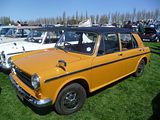
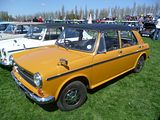
In the autumn of 1971, a Mark 3 model was launched. There were few significant differences here apart from some trim details. The model ranges were gradually reduced, but the car stayed in production until well into 1974, many months after its replacement, the Allegro had been launched. The car is notorious for rust problems, which is one reason why relatively few of the model have survived, and you always see far fewer of these than the admittedly longer running Mini, or even the Morris Minor which the car was intended to replace, but it was good that there were more here than you sometimes find.
MGB
Needing little in the way of an introduction, as it is one of the most popular classic cars out there, is the MGB, seen here in Roadster guise and also as a MGB GT, which with Portuguese plates was one of a few foreign registered cars here. Launched in October 1962, the MGB was produced for the next 18 years and it went on to become Britain’s best selling sports car and these days it has to be one of the most popular classics there is. When first announced, the MGB was an innovative, modern design, with a monocoque structure instead of the traditional body-on-frame construction used on both the MGA and MG T-types and the MGB’s rival, the Triumph TR series, though components such as the brakes and suspension were developments of the earlier 1955 MGA and the B-Series engine had its origins back in 1947. The lightweight design reduced manufacturing costs while adding to overall vehicle strength, and with a 95hp 3-bearing 1798cc engine under the bonnet, performance was quite respectable with a 0–60 mph time of just over 11 seconds. The car was rather more civilised than its predecessor, with wind-up windows now fitted as standard, and a comfortable driver’s compartment offered plenty of legroom. The roadster was the first of the MGB range to be produced. The body was a pure two-seater but a small rear seat was a rare option at one point. By making better use of space the MGB was able to offer more passenger and luggage accommodation than the earlier MGA while being 3 inches shorter overall. The suspension was also softer, giving a smoother ride, and the larger engine gave a slightly higher top speed. The four-speed gearbox was an uprated version of the one used in the MGA with an optional (electrically activated) overdrive transmission. A five-bearing engine was introduced in 1964 and a number of other modifications crept into the specification. In late 1967, sufficient changes were introduced for the factory to define a Mark II model. Alterations included synchromesh on all 4 gears with revised ratios, an optional Borg-Warner automatic gearbox, a new rear axle, and an alternator in place of the dynamo with a change to a negative earth system. To accommodate the new gearboxes there were significant changes to the sheet metal in the floorpan, and a new flat-topped transmission tunnel. US market cars got a new safety padded dashboard, but the steel item continued for the rest of the world. Rostyle wheels were introduced to replace the previous pressed steel versions in 1969 and reclining seats were standardised. 1970 also saw a new front grille, recessed, in black aluminium. The more traditional-looking polished grille returned in 1973 with a black “honeycomb” insert. Further changes in 1972 were to the interior with a new fascia. To meet impact regulations, in late 1974, the chrome bumpers were replaced with new, steel-reinforced black rubber bumpers, the one at the front incorporating the grille area as well, giving a major restyling to the B’s nose, and a matching rear bumper completed the change. New US headlight height regulations also meant that the headlamps were now too low. Rather than redesign the front of the car, British Leyland raised the car’s suspension by 1-inch. This, in combination with the new, far heavier bumpers resulted in significantly poorer handling. For the 1975 model year only, the front anti-roll bar was deleted as a cost-saving measure (though still available as an option). The damage done by the British Leyland response to US legislation was partially alleviated by revisions to the suspension geometry in 1977, when a rear anti-roll bar was made standard equipment on all models. US emissions regulations also reduced horsepower. In March 1979 British Leyland started the production of black painted limited edition MGB roadsters for the US market, meant for a total of 500 examples. Due to a high demand of the limited edition model, production ended with 6682 examples. The United Kingdom received bronze painted roadsters and a silver GT model limited editions. The production run of home market limited edition MGBs was split between 421 roadsters and 579 GTs. Meanwhile, the fixed-roof MGB GT had been introduced in October 1965, and production continued until 1980, although export to the US ceased in 1974. The MGB GT sported a ground-breaking greenhouse designed by Pininfarina and launched the sporty “hatchback” style. By combining the sloping rear window with the rear deck lid, the B GT offered the utility of a station wagon while retaining the style and shape of a coupe. This new configuration was a 2+2 design with a right-angled rear bench seat and far more luggage space than in the roadster. Relatively few components differed, although the MGB GT did receive different suspension springs and anti-roll bars and a different windscreen which was more easily and inexpensively serviceable. Although acceleration of the GT was slightly slower than that of the roadster, owing to its increased weight, top speed improved by 5 mph to 105 mph because of better aerodynamics. 523,826 examples of the MGB of all model types were built, and although many of these were initially sold new in North America, a lot have been repatriated here.
ROVER P6
There were lots of P6 Rovers here. This was the true successor to the long running P4 Rovers. First seen in October 1963, this was a very different sort of Rover. Some will claim that it took its inspiration from the Citroen DS. For sure it applied lessons learned from Rover’s own Jet Turbine program of the 1950s and early 60s. It was a “clean sheet” design, carrying nothing over, and was advanced for the time with a de Dion tube suspension at the rear, four-wheel disc brakes (inboard on the rear), and a fully synchromesh transmission. The unibody design featured non-stressed panels bolted to a unit frame. The de Dion set-up was unique in that the “tube” was in two parts that could telescope, thereby avoiding the need for sliding splines in the drive shafts, with consequent stiction under drive or braking torque, while still keeping the wheels vertical and parallel in relation to the body. The Rover 2000 won industry awards for safety when it was introduced and included a carefully designed “safety” interior. One innovative feature was the prism of glass on the top of the front side lights. This allowed the driver to see the front corner of the car in low light conditions, and also confirmed that they were operative. One unique feature of the Rover 2000 was the design of the front suspension system, in which a bell crank (an L-shaped rotating bracket trailing the upper hub carrier joint) conveyed the vertical motion of the wheel to a fore-and-aft-horizontally mounted spring fastened to the rear wall of the engine compartment. A single hydraulically damped arm was mounted on the firewall for the steering. The front suspension was designed to allow as much width for the engine compartment as possible so that Rover’s Gas Turbine engine could be fitted. In the event, the engine was never used for the production vehicle, but the engine compartment width helped the accommodation of the V8 engine adopted years after the car’s initial launch for the 2000. The luggage compartment was limited in terms of usable space, because of the “base unit” construction, complex rear suspension and, in series II vehicles, the battery location. Lack of luggage space (and hence the need to re-locate the spare tyre) led to innovative options for spare tyre provision including boot lid mountings and optional Dunlop Denovo run-flat technology. The car’s primary competitor on the domestic UK market was the Triumph 2000, also released in October 1963, just one week after the Rover, and in continental Europe, it contended in the same sector as the Citroen DS which, like the initial Rover offering, was offered only with a four-cylinder engine – a deficiency which in the Rover was resolved, four years after its launch, when Rover’s compact V8 was engineered to fit into the engine bay. The Rover 2000 interior was not as spacious as those of its Triumph and Citroen rivals, especially in the back, where its sculpted two-person rear seat implied that Rover customers wishing to accommodate three in the back of a Rover should opt for the larger and older Rover 3 Litre. The first P6 used a 1,978 cc engine designed specifically for the car, which put out around 104 bhp. That was not enough to live up to the sports saloon ambitions, so Rover later developed a twin SU carburettor version with a re-designed top end and marketed the revised specification vehicles as the 2000 TC. The 2000 TC was launched in March 1966 for export markets, Rover finally relenting and making it available to UK buyers later that year. This engine generated around 124 bhp. The standard specification engines continued in production in vehicles designated as 2000 SC models. These featured the original single SU. More performance was to come. Rover saw Buick’s compact 3528 cc V8 unit that they had been looking at developing as the means of differentiating the P6 from its chief rival, the Triumph 2000. They purchased the rights to the innovative aluminium engine, and, once improved for production by Rover’s own engineers, it became an instant hit. The Rover V8 engine, as it became known, outlived its original host, the P5B, by more than thirty years. The 3500 was introduced in April 1968, one year after the Rover company was purchased by Triumph’s owner, Leyland and continued to be offered until 1977. The light metal V8 engine weighed the same as the four-cylinder unit of the Rover 2000, and the more powerful car’s maximum speed of 114 mph as well as its 10.5-second acceleration time from 0–60 mph were considered impressive, and usefully faster than most of the cars with which, on the UK market, the car competed on price and specifications. It was necessary to modify the under-bonnet space to squeeze the V8 engine into the P6 engine bay: the front suspension cross-member had to be relocated forward, while a more visible change was an extra air intake beneath the front bumper to accommodate the larger radiator. There was no longer space under the bonnet for the car’s battery, which in the 3500 retreated to a position on the right side of the boot. Nevertheless, the overall length and width of the body were unchanged when compared with the smaller-engined original P6. Having invested heavily in the car’s engine and running gear, the manufacturer left most other aspects of the car unchanged. However, the new Rover 3500 could be readily distinguished from the 2000 thanks to various prominent V8 badges on the outside and beneath the radio. The 3500 was also delivered with a black vinyl covering on the C-pillar, although this decoration later appeared also on four-cylinder cars. A 3-speed Borg Warner 35 automatic was the only transmission until the 1971 addition of a four-speed manual 3500S model, fitted with a modified version of the gearbox used in the 2000/2200. The letter “S” did not denote “Sport”, it was chosen because it stood for something specific on those cars: “Synchromesh”. However it is important to note that the 3500S was noticeably quicker than the automatic version of this car with a 0-60mph time of 9 seconds, compared with 10.1 for the standard car. Moreover, due to the fuel-guzzling nature of automatic gearboxes of this era, the manual car’s official cycle was 24mpg compared to the automatic’s 22mpg. The Series II, or Mark II as it was actually named by Rover, was launched in 1970. All variants carried the battery in the boot and had new exterior fixtures such as a plastic front air intake (to replace the alloy version), new bonnet pressings (with V8 blips even for the 4-cylinder-engined cars) and new rear lights. The interior of the 3500 and 2000TC versions was updated with new instrumentation with circular gauges and rotary switches. The old-style instrumentation with a linear speedometer and toggle switches continued on the 2000SC versions. The final changes to the P6 came in the autumn of 1973 when the 2200 SC and 2200 TC replaced the 2000 SC and TC. These cars used an enlarged 2,205 cc version of the 2000 engine, which increased power outputs to 98 and 115 bhp respectively as well as offering improved torque. The P6 was replaced by the SD1 Rover, a completely different sort of car indeed, after 322,302 cars had been built. On show here were a 1967 2000 SC and a number of 3500 models including one of the pre facelfit models, as well as some of the later cars with their revised egg-shell grilles, introduced in the autumn of 1970, with both 2200SC and TC here and a late model 3500S in Police car spec.
Rover only ever sold the P6 in the one body design, of a four door saloon., leaving the market for Estate models in this class to arch rival Triumph, whose 2000 and 2500 sold well. But a small number of cars were converted to Estate models and this is one. Such cars were produced by Battersea-based coachbuilders FLM Panelcraft, who called the result Estoura, a contraction of the words ‘estate’ and ‘tourer’. It is believed that between 160 and 170 were produced, although the Rover P6 Club database shows 187 Estouras as having been produced. The first estate was not an approved conversion, but from 1970 onwards the car was marketed with the factory’s blessing by BL dealers HR Owen Limited and therefore factory warranties were carried forward. The conversions were completed by H.R. Owen and Crayford Engineering, with bodywork executed by FLM Panelcraft. According to P6 archivist John Windwood, Crayford’s involvement in the project was limited to the interior of the car, and the company had no bearing on the external design of the estate conversion. Nonetheless Crayford badged them as Crayfords for a while (implying that they built them) and only stopped after FLM threatened legal action. Conversions could be carried out at any time in the car’s life. Most conversions appear to have been carried out when the cars were 12 months old or older because if a car was converted when new, the conversion would have been liable for Purchase Tax like the car itself. Due to the cost of the conversion (about £800) it would appear that most were carried out on the 3500 rather than on the 2000, with even fewer 2200s made. In comparison with the Triumph 2000 estate, the Rover Estoura was of limited practicality. The quality of the conversion also left a great deal to be desired. It is thought that about 80 of them survive.
ADO17 “LAND CRAB”
The ADO17, launched initially as the Austin 1800, in October 1964, was the third of a trio of cars masterminded by Issigonis which espoused his basic beliefs of space efficiency and no undue fripperies. He often said that it was the car of which he was most proud. The market took a different view. One problem was that it was half a class larger than the most obvious rivals, such as the Ford Cortina and Vauxhall Victor, which meant that instead of replacing the Austin Cambridge, as originally intended, it ended up supplementing it in the range. Undeniably spacious, within a very compact footprint, the car was also rather basic looking inside, with a thin ribbon speedo set in a very narrow strip of dashboard, with a full width parcel shelf underneath (with an awkward umbrella handbrake sprouting somewhere to the left of the column. A Morris version, identical bar the badging arrived two years later. There were none of these original cars on display this time. What were there, though were several of the Mark 2 models which were launched in 1968, with revised styling front and back, a new dash panel and the option of a twin carb 1798 cc engine from the MGB in an S version. This was a few months after the more luxurious Wolseley 18/85 had been added to the range.

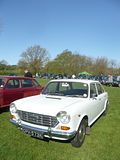
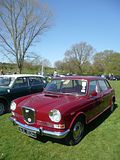

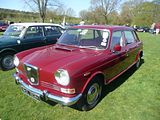
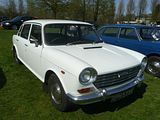
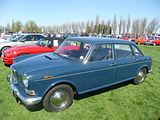
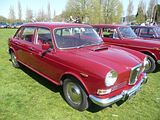
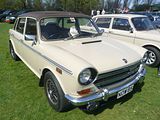
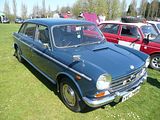
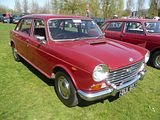

The Mark 3 came out in Spring 1972, and as well as further set of cosmetic changes, the newly created 6 cylinder version of the E series engine was offered in the Austin and Morris 2200 models, and was standard in the top of the range Wolseley Six. The Mark 3 was produced for 3 years until its replacement by the ADO71, the Princess. There were a number of these cars displayed, including a couple of the top of the range Wolseley Six.
AUSTIN 3 LITRE
Conceived as a replacement not just for the Austin Westminster, but also the Wolseley 6/110 and even the Vanden Plas Princess 3 litre, the Austin 3 litre was premiered at the 1967 Earls Court Motor Show, though production did not start until well into 1968,. by which the model had been slightly restyled with twin circular headlights replacing the oblong units of the launch car. Sharing the centre body section with the established ADO17 Austin/Morris 1800 range, the car was elongated at both ends, providing a much larger boot at the back, and space for the 3 litre inline 6 cylinder C Series engine to be installed in the front. Unlike the 1800cc cars, this one was rear wheel drive. Initial reviews were luke warm, at best, and sales were sluggish. They did not get any better as the months went by, and production ceased in 1971 after just 8600 cars had been made. Few have survived, as many met their fate on the banger racing circuit where the immense strength of the body was a real asset, but those which have – and a couple of them were on show here – are thought of more fondly now than they were when new. Martin Buckley, well known for his love of slightly off-beat classics is a particular fan.
AUSTIN MAXI
With the ADO17 Austin/Morris 1800 cars having ended up two classes above the volume selling 1100/1300 cars, BL needed a true mid-sized car, and that is where ADO15 came in. Developed during the mid 1960s, the car eventually made its debut as the Maxi on 1st May 1969. Promoted as the “5 of everything” car, it had 5 doors, 5 gears (both unusual in the market in those days) as well as 5 seats. It also featured a brand new engine, the 1500cc E Series, which was not really up to the task and it was saddled with what by common consent was one of the most recalcitrant gearchanges ever inflicted on a production car, with a lever operated by rods which had to be carefully lined up to persuade the next gear to engage. That aside, the car had huge potential and a vast amount of space in a footprint that measures less than 14 feet in length. A revised version was launched in the autumn of 1970, with a cable operated gearchange and the option of a more powerful and torquey 1750cc engine. Sadly, apart from adding the twin carburettor HLS version to the range in 1972, that was about all that BL did to the design in the next 10 years. Talk about starving a model of its full potential. The last few cars were branded Series 2 and had new bumpers and interior trim, but that was about it. What a wasted opportunity! Seen here were a couple of models from the mid 1970s in characteristically bright paint finishes of Pageant Blue and Citron as well as one of the Series 2 cars.
TRIUMPH TOLEDO
Slightly surprisingly, given the number of other marques from the BL empire that were here, this was one of only two different Triumph models present, a late model 4 door Toledo. The Toledo was one of two cars that Triumph presented to replace the innovative, but rather costly to build front wheel drive 1300 model in August 1970. To cut costs, it made the switch from front to rear wheel drive, whilst the other new car, the Triumph 1500 stayed (initially) as a front driver. Both cars had new styling which was clearly based on the 1300, but updated. Both had a new split grille at the front, but instead of the 1500’s twin round headlamps, the Toledo had single rectangular units set in a grey plastic grille. The rear end was like that of the 1300 except for the tail lights, which were of a simpler, flat-faced design. The biggest change for the Toledo was a move to rear-wheel drive and live rear axle (still with coil springs), in the interest of simplicity and low production costs. The interior was also cheaper, with wood confined to a dashboard consisting of a simple plank with holes drilled for the quite basic instrumentation but the interior was a cut above most other small cars at a time when black plastic was commonplace. Initially, the Toledo was only available as a two-door saloon with the 1300 cc engine of 58 bhp Drum brakes were fitted all round and there was no overdrive or automatic option available. In March 1971 a 4-door “special export” version was launched at the Geneva Motor Show,featuring a 1500 cc engine in single and twin carburettor “TC” form producing 61 and 64 bhp respectively. From late August 1971 the four-door model was also available on the home market. The four-door Toledo featured the same side body pressings as the Triumph 1300. The interior furnishings were in most respects indistinguishable between the two versions, but buyers of the four-door car received two extra ashtrays in each of the extra doors. Radial ply tyres were specified in place of the cross-plies offered on the two-door car, compensating for the additional 50 kg of weight involved in installing the extra doors. The two-door model featured non-wraparound front and rear bumpers, although this would change in 1973 to full wraparound bumpers, something the four-door featured from the start. Two front bumper under-riders were fitted to the two-door model; however these were deleted on later cars from around late 1972 / early 1973. The specification gradually improved over the years. In October 1972 front disc brakes were fitted as standard on both models and a heated rear window became standard equipment by late 1973 / early 1974. In March 1975 the two-door version was dropped: the four-door model continued in production for another year, but in improved specification form. The existing Triumph Herald three-rail type gearbox was replaced with a Triumph Spitfire 1500 type single-rail gearbox and the car was fitted with a new clutch. The new look Toledo was also fitted with side body trims, new look black type front grille (replacing the silver type front grille) and a stainless trim was added to the side roof guttering. The specification again improved; standard equipment now included a rear-view dipping mirror, fasten seat belt warning light, reclining front seats (previously an option), twin reversing lights (also previously an option), cigar lighter, hazard warning lights and a driver’s exterior door mirror. A laminated windscreen, front head rests and brushed nylon seat facings were optional extras. The Toledo was finally replaced by the Dolomite 1300 and 1500 in March 1976. Total production was 119,182 cars, making it one of Triumph’s best-selling small saloon cars.
MORRIS MARINA and ITAL
I know that Top Gear famously destroyed a few Morris Marina in their time, but not withstanding the fact that this car is still the butt of jokes now just as it was from birth, there is a thriving Owners Club, so I would have rather expected a few more examples of what for most of its life was one of the best selling cars in Britain. By 1968, when British Leyland was formed as a merger of BMC and British Motor Holdings, the new management were somewhat alarmed to discover that apart from the soon to be launched Maxi, there were no new models under development, and as rival brand Ford’s Cortina was performing extremely well in the market, it was decided to give priority to a mid-sized car that would replace the elderly Minor and Farina saloons and take the Ford head on in the quest for sales. Conceived,. designed and put into production in record quick time, of just 18 months, the Marina was launched in the spring of 1971. An utterly conventional car, with rear wheel drive, and simple proven mechanicals using the familiar A and B Series engines, the model was launched as a 2 door Coupe and 4 door Saloon. Unusually, the Coupe was cheaper than the Saloon, which should have given the Morris something of an advantage over the Dagenham rival, who charged quite a premium for a Capri over a Cortina. However, the Marina had one attribute which completely eluded the Ford, certainly in its more powerful guises: terminal understeer. It is understood that when the British press got the chance to drive the car some while before launch, they all complained bitterly about this and the dire consequences that could follow, but BL management assured them that this would be fixed for the production cars. It was not, and a usually loyal press struggled to contain their disappointment in what they wrote in early Road Tests. About 30,000 cars were built like this before a revised suspension design was deployed and gradually the early cars were tamed somewhat. This weakness not withstanding, the Marina quickly picked up sales, and although it hardly ever outsold the Cortina in any given month, it became a strong performer in the UK Sales Charts, all the more so when an Estate model was added to the range in the autumn of 1972. Seen here, in the very period colour of Limeflower is a 1.8 Super saloon.
The Marina was only intended to have a short life, very much like contemporary Ford products which were replaced every 4 or so years, but by the mid 1970s, BL had run out of money and had to be rescued by the British Government. That meant that there were no funds for an all new car, so the proposed ADO77 replacement model was cancelled, and the Marina was simply facelifted in the autumn of 1975 to create the Series 2, with revised suspension, new seats, a new dash to create more room for the front passenger, and upgraded equipment levels. It was not really enough to fight off not just the Cortina but the growing threat from the Cavalier which from the end of 1977 had become a British built car and thus more acceptable in the minds of many a Fleet Manager. BL resorted to the famous trick of producing a limited edition model to try to shift some stock, knowing that a facelifted car was imminent, so the LE was born in April 1978, with a vinyl roof, driving lights set in the grille, coachlines and special badging along with a unique to the model Oyster Metallic paint finish and there was one of these on show.
The second major update to the Marina came in the autumn of 1978 when the new 1700cc O Series engines were ready to replace the venerable B series unit. As the 70s went on, the Marina’s limitations in the face of more modern competition not just from Ford, but Vauxhall’s Cavalier, the Car of the Year winning hatchback Chrysler’s Alpine, a whole slew of Japanese rivals such as the Datsun Bluebird and Toyota Carina as well as the Renault R12 and VW Passat made life ever more difficult for the car, and it was only significant fleet sales from a sector which still largely held a “Buy British” policy and something of a fear of the costs of front wheel drive cars which kept the car earning money for its maker. But soldier on it had to, as priority had been given to the Metro, which meant that this car would have to live on into the 1980s. To help it, BL decided a new look, and a new name were required and in the summer of 1980, the Ital was launched. It took its name from Giorgetto Giugiaro’s ItalDesign studio, who had been employed by BL to manage the re-engineering of the Morris Marina, though it was actually Harris Mann who was responsible for the car’s new look. BL’s advertising, however, emphasised the car’s connection with the Italian styling house Italdesign. The Coupe models were dropped, leaving just Saloon, Estate and Van version, all of which had revised exterior styling, but retained the Marina’s 1.3- and 1.7-litre petrol engines and rear-wheel drive chassis. The dashboard and interior of the Marina were also carried over largely unaltered. From October 1980 an automatic version was available with the 2.0-litre O-Series power unit, as the range-topping 2.0HLS. Only about 1,000 2.0HLS models were sold so due to this and their short production run, the 2.0HLS is now the rarest Ital model. In November 1981 all HL and HLS models were fitted with upgraded interior trim. In September 1982, a revised Ital range was introduced. The L and 2.0 litre models were dropped and the HL and HLS were replaced by the SL and SLX models. Front suspension was changed to telescopic front dampers across the range and parabolic rear springs were also fitted, together with additional soundproofing and improved trim. Thus cropped, the range now consisted of the 1.3 SL and SLX saloon, 1.3 SL estate, 1.7 SLX saloon, and the 1.7 SL saloon and estate. These final models ran until the end of Morris production in 1984 when the car was replaced by the Montego. Itals proved just as susceptible to rust as the Marina, and survival rates are very low, so it was nice to see this well preserved model here.
Although it is fashionable to decry the Marina and Ital, the fact that a car intended to have a 4 year life sold for 13 years, and was second only to the Metro in terms of number of models produced suggests that it was more of a car that people needed and could afford than our collective memories might now have us believe.
AUSTIN ALLEGRO
I guess the same could be said about ADO67, the Allegro, a car launched on 15th May 1973 with Autocar’s cover proclaiming (with no hint as to how ironic or not they were being) “Britain’s Next Best Seller”. Of course, it was not. The UK sales championship held for many years by the ADO16 range had been lost of the Ford Cortina, and apart from a few odd months when the Metro would regain it, a BL car would never achieve market leadership again. And as to why that would be. well I am sure that all the words that can be said on the subject have already been aired? There was certainly nothing wrong with the model’s potential, as only a year after the launch of the Allegro, a similarly sized car, actually with a more limited range of engines, was launched, and it came to dominate the class. That car, of course, was the VW Golf, and the difference between how VW – starved of money thanks to building Beetles for too long – and BL went about the task of building a family sized lower-medium sized car could not be marked. Despite the warning signs of some rather guarded reviews at the launch, which should have given a few clues that all was not as it should have been, a BL management who managed to combine arrogance with naivete and a certain lack of vision continued confidently asserted that the Allegro would regain a position at the top of the sales charts. It did not. Build quality of the early cars was random, and frequently plain unacceptable, and despite being bigger than the car that it replaced, there was no more space in it. A slightly odd looking Estate model was added to the range in the summer of 1975, a matter of weeks before the launch of the Series 2 models, which arrived in the autumn that year. They did at least fix the rear seat spaces issue, offering up to 6″ more legroom, and with better quality trim, and a conventional round steering wheel rather than the unusual Quartic one of the launch cars. When built properly – and some of them were – the reality is that the Allegro was rather better than its reputation then (and now) would suggest. For sure, it was somewhat outclassed by the VW Golf, but that was considerably more costly model for model, but there were several aspects where it could match or beat an Escort or a Viva. The E series engined 1500 and 1750 cars, with standard 5 speed gearboxes were never as popular as anticipated, the market not really being ready for the idea of a large engined small car, but anyone who did buy a 1750SS or the later HL had a very brisk car indeed on their hands. By the late 70s, with a whole slew of much newer models on offer from every single competitor, the car, although better built and with a nicer interior finish, was simply too old fashioned for most people. It is testament to marketing and the skills of the dealers that the car continued to sell into the Eighties in the volumes that it did. One of those dealers was a young and enthusiastic chap called Colin Corke. These days he is the Vicar of Longbridge, and still a great enthusiast for this model (and other BL cars, which we will come to later in this report). His beautifully presented early 1750SS was on show. This car underwent a fastidious restoration a number of years ago, and is, Colin will joke, probably better built than when it left the plant the first time round!
Joining it was another 1750SS.
By far the most numerous Allegro model here was the Vanden Plas, with around half a dozen of them present. Although we think of these cars as an Allegro, that badge was not used, and the car was officially called the Vanden Plas 1500, and later the Vanden Plas 1750. Introduced in September 1974, this car followed on from the popular Vanden Plas 1100 and 1300 models as a very upmarket version of a volume selling car. It featured a prominent grille at the front and an interior enhanced by a range of modifications designed to attract traditionally inclined customers, including: special seats upholstered in real leather, with reclining backrests; deep-pile carpets; extra sound insulation; a new instrument panel in walnut; walnut folding tables for the rear passengers; nylon headlining; and for the luggage, a fully trimmed boot. In 1974, a time when the UK starting price for the Austin Allegro was given as £1159, BLMC were quoting, at launch, a list price of £1951 for the Vanden Plas 1500. The larger 1750 cc engine was added to the range a few years later. The model changed little during its production run.
Also among the Allegros were a pair of Estate cars, a Series 2 and a Series 3, both in yellow – Inca and Snapdragon, respectively, and finally there was a single Series 3 Saloon.
SHERPA
Originally developed by British Leyland, this model was launched in 1974 under the nameplate Leyland Van. A year later the name of the model was changed to the Leyland Sherpa. The Sherpa would then be branded by Morris and later Freight Rover. Derived from the Morris/BMC J4 & JU250 vans of the 1960s, the Sherpa Van brought with it a number of developments over its predecessor, the main one being the revision of the forward control layout of the J4 and moving the engine ahead of the cab and accessible via a bonnet. This allowed the wheelbase to be extended resulting in greater stability, payload, side loading and the distinctive ‘Sherpa’ profile (though the last of the J4s and the first Sherpa are largely identical from the rear). The initial Sherpa line-up consisted of vans in 185, 215 and 240 versions (where 185 denotes a GVW of 1.85 tons, and so on); pick-ups in 215 and 240 versions; a 240 crewbus and minibus; and various chassis-cab options in 220 and 250 versions. Payloads were quoted as 13/14cwt for the 185; 18/19cwt for the 215 and 220; and 22/23cwt for the 240 and 250. Loadspace, at 190 cubic feet, was considerably greater than that of the J4 and only just short of the 250JU’s. In 1978, 1.7- and 2.0-litre O-series engines replaced the original 1622 cc and 1798 cc B-series petrol units, while the 1798 cc B-series diesel remained on offer. The range was redesignated accordingly:- vans: 200, 230 and 250; pick-ups: 230 and 250; minibus and crewbus: 250 only; chassis-cab: 255 only. A few months later, the Sherpa was rebadged as a Morris. In 1981, BL created the Freight Rover division as part of the Land Rover group, so the Sherpa’s badges were changed again. The Sherpa gave way to the Freight Rover 200 Series and in turn the Leyland DAF 200 Series before finally becoming the Pilot after LDV was formed in 1993. It was originally designed to be built on car production lines which led to it having a narrow track. This feature was made into a virtue in later publicity by stressing its ability in narrow city streets – this indeed was why the Sherpa series was for many years, preferred over the Ford Transit by the Royal Mail, in particular. A number of them were converted into motorcaravans by specialists such as Devon and SunTors, to provide a rival to the popular VW Type 2, and this is one such example.
18/22 SERIES and PRINCESS
With 2015 marking the 40th anniversary of the striking wedge shaped ADO71 cars, I was rather expecting to find a whole load of these cars on display. But I did not. The official launch had been on 29th March 1975, and there had been a well attended assembly of the cars at Cowley on 29th March, so perhaps it was expecting too much for these machines to head out again just three weeks later. The ADO71 had been eagerly awaited, as a replacement for the venerable “Land Crab”. This was an era when there were very few spy photos of prototypes published (or leaked) unlike today, so it was quite a shock to discover the bold new wedge styling that Harris Mann had proposed on the new car. I do recall – and now I can confess – getting hold of a couple of brochures for the car some weeks before launch, as my parents were in the process of buying a new Mini, and I spotted them on the shelf in the dealer’s office. At launch, the car was called the 18-22 Series, and came in Austin, Morris and Wolseley versions, with the 1798cc B Series and 2226cc E Series engines carried over from the ADO17. In this guise, the model last only until September before the range was revised and a new name was adopted, Princess. Not surprisingly, there are very few of the pre-Princess cars still left, but one of them, an Austin 1800HL, was one of the two ADO71s here. Redolent of the sort of chaos that pertained at BL, in September 1975, the model was rechristened the Princess, and was sold with the same choice of 1800 or 2200cc engines, in HL and HLS trim. Princess 2 arrived in the summer of 1978 when the venerable B Series engines were replaced by the all new O Series unit, offered in 1700 and 2000cc guises. Minor changes to the trim and decor were made at this time. The other car on show here was a Series 2 model.
ROVER SD1
Next year will see the 40th anniversary of the launch of the Rover SD1, and I would imagine that there will be several events to mark the occasion. It is hard to imagine now just how excited people were when this dramatically different looking Rover burst onto the scene in July 1976. These days it takes a very extreme supercar for most car enthusiasts to get truly animated, but back then, a 3.5 litre V8 engined 5 seater British hatchback was all it took, and it was no surprise that the model collected the “Car of the Year” award later in 1976, fending off the second placed Ford Fiesta and the new Audi 100. Replacing both the Rover P6 and the big Triumphs which had been launched at the 1963 Motor Show and updated only in detail since then, this new David Bache styled car, with more than a hint of Ferrari Daytona in its profile really was something very different indeed to look at, even if underneath it was more of a clever update of proven mechanicals, with the 3.5 litre V8 engine carried over from its predecessor. Early press reports suggested that the car was as good to drive as it was to behold, and quickly there were long waiting lists as Rover struggled to produce the car fast enough in an all-new manufacturing facility in Solihull. Sadly, it did not take too long before it became apparent that although the car had been a long time in gestation, there were a number of design and manufacturing quality issues, quite apart form the extra ones that were inflicted by a still very truculent and strike-prone workforce. These frustrations did little to quell demand, though, which increased when the promised 6 cylinder models arrived in the autumn of 1977. 2300 and 2600 models sported a new 6 cylinder engine and were the more obvious replacement for the big Triumph and the Rover 2200 than the V8 car had been. BL’s next move was to take the car up market with the launch of the V8S in 1979 which was available in a rather bright Triton Green metallic paint and a choice of gold or silver alloy wheels, as well having a far higher standard level of equipment. It was replaced by the even more luxurious Vanden Plas model in late 1980. There are not that many of the early cars left now, but seen here were a 3500 from the first few months of production, along with a slightly later one and a 2600 in the very period Avocado colour that suited it, but which you just could not imagine anyone wanting these days!
A more significant change was a facelift which came in early 1982. A revised rear window line was aimed at improving the rather limited rear visibility and finally a rear wiper was fitted, this having been excluded from the earlier cars as it had been deemed unnecessary by a BL management who still thought that they knew better than the customers who clamoured for one) and the bumpers and lights were altered, along with significant interior trim and equipment changes. A few weeks later, a cheaper 4 cylinder 2000 model appeared, with the O Series engine under the bonnet, aimed at the all important fleet market and later that year it was joined by a diesel version, using the VM Motor engine, creating the 90 bhp 2400SD. The real joy though was the car revealed at the 1982 British Motor Show, the Vitesse, which boasted fuel injection and 190 bhp to give the car better performance, and with a new front and rear spoiler, the looks to suggest that this was an Autobahn-stormer to rival BMW and Mercedes. Of course, the other reason for the Vitesse was so as to homologate some of the changes for what turned out to be a less than successful career on the race track. It was this which led to the final handful of Vitesse models having a further power upgrade with the TwinPlenum versions, and these are the most highly prized cars of the lot these days. That said, values of SD1 remain very low, with the result that the majority of the cars have been scrapped as they are economic to restore. You see more Vitesse models than anything else and that was the case here, but there were also some of the lesser Vanden Plas models on show as well.
AUSTIN MG and ROVER METRO
“A British car to beat the world”. So read the billboards when the Austin Metro was revealed in October 1980. We had waited a long time for this car. There were many false starts, with thoughts first turning to how to replace the Mini going back to the late 1960s, but for various reasons, every effort had been cancelled. Fortunately, that extended to the ADO88 prototype which got to quite an advanced state of development in 1978, but which received less than favourable feedback at customer clinics. A hasty redesign was conducted. Despite carrying over the A Series engines, albeit in modified A+ guise, as BL had nothing else suitable and no money to develop an alternative, and that meant the 4 speed in-sump gearbox came with it, the little Metro was an immediate hit. It looked good, with pert, modern styling, and was practical with a large hatchback, and some innovative ideas on how to maximise the use of space. This was a roomy car that Britain could indeed be proud of. That a young lady who came to prominence in the months following launch, the future Princess Diana, could be seen driving around in one probably helped still further. Five models were available at launch: 1.0, 1.0L, the economy-oriented 1.0 HLE, 1.3S and 1.3 HLS, and the cars were available in a wide range of bright and attractive colours, including a greater percentage of metallic paints than were typically offered to buyers of cars in this class. My parents bought a 1.0L in the summer of 1983, as a replacement for our Mini, and the car was a massive improvement in just about every respect. Unlike previous BL cars, this model was not dogged with build quality and reliability issues, though, sadly it did have the same propensity to rust as they had done, but it took several years before that would become obvious. Before that happened, the range was expanded with the introduction of cheaper a model using AP’s clever 4 speed Automatic gearbox, cheaper City and City X models, a top spec Vanden Plans and then the sporting MG version. There was a lot of angst about this last one, as the purists all bemoaned the fact that it was not a “real” MG, as it was a family hatchback not a sports car (conveniently ignoring the MG 1100/1300 saloons of the 1960s), but ti soon became apparent that this little car was a blast to drive, and something quite special with its red trim, including red seat belts and a liberal splashing of octagon logos around the car. A wilder Turbo model followed at the end of 1982, reflecting the craze for every manufacturer to bolt one on to every car that they could find to create a series of often rather unruly and lag-prone but fast machines. Although a lot of work was done in the mid 80s on developing what should have been another world class replacement (the AR6, the prototype for which is also hidden away at Gaydon), a lack of funds meant that for the next 7 years, all that happened was a lot of tweaking of the the trim, and specification and the incorporation of a pair of rear doors to create a 5 door model. This was at a time when the competition stood far from still, with the Fiat Uno and Peugeot 205 upping the ante in early 1983, Vaxuhall joining the fray with the Nova mid year, a facelifted Fiesta with a five speed gearbox arriving later that year, a new Renault R5 the following year, along with several Japanese rivals coming out every 4 years, but despite this making the Metro look increasingly elderly, and also small, compared to all its rivals, it continued to sell in vast quantity with over a million of them being made in 10 years. Survival rates are pretty low, though, thanks largely to the tendency for the cars to rust, but interest in the car is now rebuilding, so it was good to see quite so many Metro models here, including the pristine MG Metro and the exceedingly low mileage 1.3 Automatic both owned by Rev Colin Corke (who had also brought along his Allegro SS).
Throughout the 80s, a number of limited edition models were produced. All the effort with these went on the trim details, some using bespoke colours, and generally with new graphics and stickers, some of them with corresponding versions in the rest of the range, such as the Advantage cars of the late 80s . A couple of them were here, an ARX and a Jet Black.
A van version was added to the range. This had the same silhouette as the regular hatch, but with the rear side windows filled in and the rear seats removed. Known sometimes as Metrovan, this version bore Morris badges for a while, as all remaining commercials in the range did in the early 80s. There were a couple of them here, including a 310 Van which had been used by one of the Utility companies on the south coast early in its life.
In May 1990, a heavily revised car was revealed. The looks had been modernised, but it was what had been done under the bonnet that was far more significant, with the relatively new K-Series engine finding a home under the bonnet. Offered in both 1100 and 1400cc guises and combined finally with a five speed gearbox in more costly models, and a new trim that looked decidedly up-market for a small car, suddenly the Metro was back in contention, and that year, the model won high praise and just about every comparison test there was. The MGs were no more, but there was a 1.4 GTi car at the top of the range, and there was even a (very low volume) Cabrio for a while. Sadly, though, with development funds still next to non-existent, the car stayed in production for too long. By 1997, the basic design was 17 years old, and it was the fact that it had the safety standards more akin to cars of 1980 than 1997 that finally finished it off, with a disastrous NCAP safety test which deterred all but the very faithful form buying it. There were several examples of the K-Series cars here, some of which were the alter Rover 100 models and amongst them was a rare Cabrio.
There were also a trio of the 6R4 cars here. With 4WD and a mid engine, the MG Metro 6R4, a 6-cylinder four wheel drive rally car, was a world away from the supermini to which it bore only a superficial cosmetic resemblance. Produced as Austin-Rover’s attempt to claim glory in Group B rallying, the competition car effectively only shared the name of the production Metro as it featured a mid-mounted engine with four wheel drive transmission enclosed within a seam-welded tubular chassis. The development of this vehicle had been entrusted to Williams Grand Prix Engineering. The resulting car was shown to the world in May 1985. It was powered by a David Wood designed bespoke 3-litre V6 powerplant which used some of the engine architecture of the Cosworth DFV. It featured twin overhead camshafts and four valves per cylinder. The engine was a break from the norm, as it wasn’t turbocharged as the majority of its competitors were. The engine was mounted back to front in the car, with the forward end of the engine facing the hatchback and the gearbox attached conventionally behind it and, therefore, in the middle of the vehicle. The four-wheel-drive was permanently engaged, and drove separate propshafts to the front and rear differentials. The rear differential was mounted on the side of the engine sump with one driveshaft running through the sump to the nearside rear wheel. Much of the outer bodywork was made of GRP, with the only exception being the roof panels (which were aluminium) and the steel doors. These were, however, concealed by plastic airboxes. Indeed, models now on show generally have stickers demonstrating where it is safe to push from when moving the vehicle, so as not to damage the bodywork. The 6R4 appeared in two guises. There was a so-called Clubman model which was the road going version which developed in the region of 250 bhp (186 kW), of which around 200 were made and sold to the public (the homologation version). A further 20 were taken and built to International specifications which had a recorded output of over 410 bhp. The car never achieved its potential, as Group B rallying came to an end in 1986, and with it the car lost its prime purpose.
TRIUMPH ACCLAIM
The last car ever to bear the Triumph was this, the Acclaim. A front-wheel drive medium-sized family car made from 1981 to 1984, it t was based on the Honda Ballade and used a Honda-designed engine, but met United Kingdom component-content requirements which were still in place at the time. Not only was it the final model of the Triumph marque, and the first fundamentally Japanese car to be assembled in Europe, it was also the first product as a result of the partnership with Honda which ran for over 15 years. The development process began in 1978, when British Leyland entered into negotiations with Honda to develop a new small family saloon, originally intended as a stopgap measure until the Maestro/Montego models were to be ready for production in 1983. On 26 December 1979 Michael Edwardes officially signed a collaboration between the two companies. The new car went into production 18 months later, badged as the Triumph Acclaim and based on the Honda Ballade. It replaced the Triumph Dolomite of the 1970s. The Acclaim was officially launched by BL on 7 October 1981 and with the ending of Dolomite and TR7 production, it meant that the Acclaim was the only car to wear the Triumph badge after 1981. The Acclaim was significant as the first essentially Japanese car to be built within the European Economic Community (now the European Union), to bypass Japan’s voluntary limit of 11 percent market of the total number of European sales. The Acclaim was also a major turnaround point for BL itself, with the car sporting good reliability and build quality from the outset. The Acclaim holds the record for the fewest warranty claims for a BL car. Unlike previous Triumphs, it was assembled at the Pressed Steel Fisher Plant at Cowley Oxford, taking over the withdrawn Austin Maxi production lines. It paved the way for the Honda-based, Rover-badged range of cars which BL, Austin Rover and Rover Group would develop throughout the 1980s and 1990s. There was not time to do much about the styling, with the most notable outward change from the Honda being the appearance of a central badge on the grille. At the time, the Japanese model had “Honda” to the right-hand side of the grille. Other changes included twin Keihin carburettors (the Ballade had only a single carburettor), the mirrors were situated on the doors, the independent front and rear MacPherson strut suspension was tweaked for the UK market and the seats were based on Morris Ital frames. The Acclaim was provided in a more luxurious interior trim than its Honda equivalent, even in its base models. The brakes were disc at the front and drum at the rear. All Acclaims were powered by the transverse-mounted all alloy and overhead-cam 1335 cc engine found in the Honda Civic driving the front wheels through either a five-speed manual gearbox or a three-speed Trio-matic gearbox (a manually selectable automatic transmission, the same as the Hondamatic) and the interior was nearly identical (except for the seats). The usual BL trim levels were offered: L, HL, HLS and the top of the range CD, which had front and rear electric windows, chrome bumpers, headlamp washers, 165/70 tyres (the L had 145/80 tyres and the HL & HLS had 155/80 tyres), plastic wheel trims, velour upholstery with seat pockets on the back of the front seats, front seat head restraints and optional air conditioning. The car remained largely the same throughout its production life. A Mark 2 version of the Acclaim came out in 1983 (from VI No. 180415 onwards). The main changes were to the exterior door handles, an electronic digital clock replaced the previous mechanical one, a restyled steering wheel, a restyled gear knob, the rear interior door handles (they were just swapped) and the heater recirculation control, which was moved. Mark 2 HL and HLS cars were better equipped than the earlier ones. There was a limited-edition Avon Acclaim that had leather seats with piping to match the body colour, leather door panels, wooden and leather trimmed dashboard, wooden door cappings, two-tone metallic paint, colour-coded wheels with chrome embellishers, chrome-plated grille, colour-coded headlamp surrounds, vinyl roof and extra soundproofing. There was also an Avon Turbo, which had Lunar alloy wheels with 205/60 tyres, suede upholstery, front air dam, and side decals. A Turbo Technics turbocharger increased the engine’s power output from the standard 70 bhp to 105 bhp. It is thought that there are only four surviving Avon Turbos including the press car (VWK689X), which was the first Avon Turbo. In 1982 and 1983, the Acclaim featured in the top-ten-selling cars in Britain, the first Triumph to achieve this feat since records began in 1965. Production finished in the summer of 1984 when the Rover 200 was launched, based on the next incarnation of the Honda Ballade. A total of 133,625 Acclaims were produced, the vast majority of which were sold in the UK, with the last Acclaim off the production line (a silver CD with the Trio-matic) now in the Heritage Motor Centre. The Acclaim’s demise saw the end of the Triumph marque as a car. You don’t see Acclaims very often so it was good to find a couple of well preserved ones here.
AUSTIN AMBASSADOR
There were 2 examples of the short-lived Ambassador here. Many will tell you that this is the car that the Princess should always have been from launch, that is a hatchback. It is still not clear why Harris Mann’s boldly styled ADO71 car went into production with a small boot opening instead of the more useful large rear tailgate. By the time the Ambassador was launched in March 1982, the Princess had been on sale for 7 years, and so even a comprehensive facelift, which is what this change was – despite the fact that all the body panels apart from the front door skins were apparently new – could not really hope to compete against the recently launched all-new Vauxhall Cavalier or even Ford’ Sierra which would arrive later in the year. The Ambassador did have roominess on its side, with a lot of space for rear passengers, but it also had BL Build Quality, and some of the cars proved to be not particularly reliable. The 2.2 litre 6 cylinder E series engine was not offered, meaning that Ambassadors only came with the O Series engine, in 1700 and 2000cc guise. Top spec models, the HLS and Vanden Plas had a twin carburettor engine, but even these did not have a 5 speed gearbox, which was fast becoming a necessity for cars in this class. That coupled with the fact that the cars were not very inspiring to drive meant that despite the fact that the top spec cars were quite well equipped and nicely trimmed inside, the model’s appeal was limited. The Ambassador was only ever going to have a short life, as it was deleted once the Austin Montego hit the market in April 1984. Although engineered for left and right hand drive, only right hand drive models went into production, so the car was only sold in the UK. 43,427 were built in the two years which it was available, of which only a handful are still on the road, with a few more in SORN status.
AUSTIN and MG MAESTRO
It was March 1983 when LM10, the new mid-sized Austin-Rover Group car was finally revealed. Design work on this one had started back in the mid 70s, even before the Metro, but the decision had been taken to prioritise the smaller car, with the result that by the time the Maestro appeared, it already looked a bit old-fashioned. There was no doubting its roominess, though, which was achieved partly because this was an attribute that BL always focused on, and also because it was a physically larger car than many of its rivals, straddling the C-segment cars like the Golf and Escort and the larger D-Segment machines such as the Sierra and Cavalier. Delayed it may have been, but the new engine for the more potent models was still not ready, so the first 1600cc cars came with the R Series unit, a hasty update on the E Series, which lasted only a year or so. 1300cc models still had the A+ unit, and still had the four speed gearbox, or the 3+E in the case of the 1.3 HLE economy model, which was disappointing as five speed units were at least an option on all the car’s rivals. The British press gave it a cautious welcome, but you could tell that they were a little disappointed. No amount of promoting the talking dashboard, a new technology gimmick was going to get over that, sadly. Nor was the fact that there was a lively MG version which hit the streets a few months later. Installation of the new S series engines in 1984, the announcement of the 2 litre MG version (which was widely praised as being a very good car) and upgraded trim over the years did little to change the car’s image and reputation, and although sales were steady, they never got close to the volumes an over-optimistic maker had forecast at launch. Nonetheless the car achieved a decent number of sales in the UK (it never really did that well anywhere else), with over 600,000 finding buyers, offering honest motoring from what was a relatively simple package. The cars changed little throughout their product life, and no amount of jazzy two tone paint finishes were ever going to make the car particularly stylish and trendy, but the adoption of the better quality Montego dashboard eliminated most of the rattles and from late 1988, the interior trim was quite plush, certainly a cut above rival Ford and Vauxhall products.
There were a number of MG Maestro models here. One of them was the now very rare R Series Weber twin carburettor engined 1.6 model, which was produced for less than a year, and there were several of the later 2.0i cars as well.
At the NEC Birmingham Show in October 1988, Austin-Rover Group showed a Turbo version of the MG, and it was launched in early 1989. The final car from Austin-Rover, before the company changed names again to Rover Group, this was only ever intended to be a limited edition car with 500 cars for sale and 5 press cars. It made use of the 2.0’s already impressive engine, but the combination of carburettor and turbocharger gave it a top speed of 128 mph and an 0–60 mph time of 6.7 seconds. It was faster than the majority of its competitors, but the high performance, Tickford designed bodykit and alloys did little to disguise the fact that it was very much still a Maestro. Sales were slow, as it appeared six years after the Maestro’s launch. There were a number of them on show here.
A very practical Van was added to the range, to replace the long-running Marina/Ital, and these were popular with several well known UK household names, such as British Telecom and the AA. Few have survived, but there were a couple here.
By 1989, Rover had a much “better” C-Segment hatch in their range, the R8 model 200, but the decision was taken to keep the Maestro in production for a while longer, to offer a cheaper alternative, for those who found the Rover’s asking prices too much. That meant a concentration of the bottom of the range, and lots of clever tweaking of the specifications. It resulted in versions like the Special, with black painted bumpers. In 1993, however, production fell to just over 7,000 units and in its final year, 1994, just over 4,000 were produced, the last one rolling off the production line in December. That was not quite the end of the story, though. In September 1995 production was transferred to Varna, Bulgaria, in complete knock down (CKD) kit form. Around 2,000 vehicles were produced before the company, Rodacar AD ceased production in April 1996 due to high import costs of the components and little demand for the cars. The majority of the Maestros produced were exported to other countries, including the UK. A small number of these were sold by Apple 2000 Ltd. of Bury St Edmunds, and registered on an “N” prefix. In 1997, Parkway Services of Ledbury, Herefordshire, purchased a batch of 621 Maestro cars and vans in CKD kit form. These had been stored at Cowley, Oxfordshire, since their production in mid-1996, when they became surplus to requirements. The company built up the cars and converted the majority of them to RHD form using up Rover’s supply of parts. The National Database for Motoring Insurance has records of models registered between “R” and “51” number plates, meaning the overall period of Maestro availability, new in the United Kingdom, was from 1983 to 2001.
AUSTIN and MG MONTEGO
As a former Montego owner – I had two of them, as my first company cars – I am always pleased to see these once popular but now almost extinct cars at events like this. Despite what people often say, these were actually pretty good cars, certainly way better than the Sierra, and provided you got a well built one (sadly, that was not all of them!), a decent reliable family car that was spacious and well trimmed. despite showing lots of promise, the car never managed to topple the Sierra or Cavalier in the market, but even so, the number of times you hear people say that they had one – and most of those who did talk positively about the experience – reminds us all that this was a decent car in its day. It was a long time coming, of course, going through the many twists and turns of its makers fortunes. In the late 70s, it was the D-Segment that mattered more than anything else in the UK. Britain’s best seller, the Ford Cortina had in excess of 10% of the entire UK car market. BL had no serious rival, offering the Marina, and subsequent Ital, that were conceived as hasty stop-gaps in the early 70s and forced to live on long beyond their reasonable model life. After the cancellation of ADO77, a conventional four door saloon that was more like a revamped Marina than a truly modern family car, the next set of plans called for a 3 box version of the Maestro. As that car was half a class smaller than the Cortina and Cavalier, that would have been a difficult strategy, and fortunately, a change of management in the early 80s saw it as such and the LM11 car that was then being developed both grew in size, and also underwent some very late styling changes as new designer Roy Axe was somewhat aghast at what had been planned. The result was the Montego, launched in late April 1984. Aimed directly at the Sierra and Cavalier, this 3 box saloon came with the new S Series 1600cc and familiar O Series 2 litre engine in 5 trim levels, priced to take on its rivals head on. Sales projections once again were somewhat optimistic, but the Montego quickly reached the Top 10 list, and many would tell you that the car was actually “better” than its Ford or GM rivals in many respects. A capacious Estate model was added to the range in the autumn of 1984. My father bought one the following summer. He did nearly 100,000 miles in it, before it was sold and then I used to see it driving around Cheltenham, as a taxi, for several years, so I am guessing that it probably did around a quarter of a million miles. Some people had problems with their cars, but it seemed to be down to luck whether you got a bad one or not. My first company car was a 1.6L model, in Targa Red, chosen not just because of the good experience from my father’s car., but because by this time it had a standard five speed gearbox when the Ford and Vauxhall did not. I was so impressed with mine and the improvements made in 1988 when a new and very plush interior was put in the car, along with the substitution of the VW gearbox for a Honda one on the 1600cc models, that I ordered another one in early 1990. By this stage, of course, it was not fashionable to like the car at all, but the reality is that whilst not exciting, except in the MG and MG Turbo guises which I coveted but could not afford, this was a practical and roomy car.
Among company car drivers, the Cavalier SRi was particularly aspirational, with its sporting appearance even though it had no more power (until the SRi 130 models of 1987 came out) than the other 1800cc models in the range. MG decided to try to capture a share of this market with the MG Montego. It was launched in August 1984, and offered not just a liberal dose of the famous MG octagon badge on the car and some of the other red trim tricks of the smaller Metro and Maestro, but a fuel injected 2 litre engine which gave it a peppy performance. The real excitement came the following summer, though, when a turbo was bolted on. The 150 bhp Montego Turbo was a fast car. A bit too fast and unruly for the chassis, if truth be told, but this was the version I would have really liked to own when I had to content myself with a “humble” 1.6L. In that regard, MG achieved exactly what Vauxhall had done, in luring customers to the top of the range model, even though they had to content themselves with the cooking version for now. There are not that many MG models left, so it was nice to see some here, both normally aspirated and Turbo cars.
After 1992, the Montego continued to be available to fleet customers for another couple of years in Saloon guise and retail purchasers could still get hold of the very practical Estate model. A Perkins developed diesel, with direct fuel injection had been introduced in 1990, and although this unit was a bit noisy, it was one of the best diesel engines available on the market at the time, second only perhaps to the Peugoet-Citroen XUD unit, which meant that there was still decent demand for the Montego even though it was now quite an old design. These cars tended to cover huge mileages, but there are still a few of them around, such as this late model Countryman D Estate.
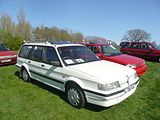
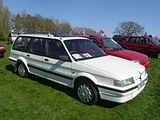
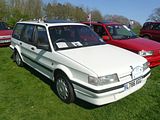
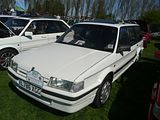
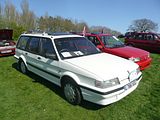
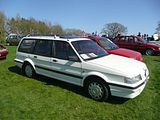
ROVER 213/216
A matter of weeks after launching the Montego, Rover came up with another family saloon, this one slightly smaller, but positioned to be a more premium entry, complete with Rover badging. The second result of the joint venture with Honda, this time the UK company had a little more input into the car than the first one, the Triumph Acclaim of 1981 which had emerged as little more than a Honda Ballade with Triumph badges on it. The new car here, whilst maintaining the same basic silhouette as the new latest Ballade looked different from the Honda, and the more powerful models had the Group’s new S Series 1600cc engine under the bonnet. Less powerful models still had the Honda 1342cc unit, but that was no bad thing as this was a smooth and refined engine. The trim was made more deliberately premium looking, in accordance with the Rover badging. I drove a number of 213 and 216 models as rental cars when I was waiting for my first company car to arrive, and they were very agreeable indeed, with the only demerit being that they were tight on space in the rear seats and the boot. The car sold well over a 5 year life, but with even the fuel injected Vitesse version not being that sporting a model, there was little to attract the enthusiast, which is probably one reason why the survival rate of these SD3 Rovers is lower even than the Montego. There were a couple of 216 Vanden Plas models as well as a 213 SE here.
ROVER 800
Next new car from what was now know as Austin-Rover was the fruits of the XX project, emerging as the Rover 800 in July 1986. Replacing the much loved, but now 10 year old Rover SD1 design, this was another joint development effort with Honda. Not that you would know it by looking at the cars, as the Honda Legend looked completely different from the Rover. The 2.5 litre engines were shared, but Rover also installed their new M Series 2 litre unit under the bonnet, which in multi-point fuel injected guise in the Si and SLi models had a good 20 bhp more power than all its rivals, making this a rapid and refined executive car. Shame is that the early production concentrated on the V6 models, which were seen as a retrograde step compared to the sonorous V8 of their predecessor, and also somewhat lacking in torque (an upgrade to 2.7 litres in February 1988 addressed the latter issue to some extent). A conventional four door saloon on launch, a five door hatchback was added to the range a couple of years later, as well as a cheaper version with the O Series engine under the bonnet aimed at the fleet market. Towards the end of production of the XX car, before it was replaced by the R17 facelift in late 1991, here was also a brief run of just over 500 820 Turbo 16v cars which used a turbocharged version of the M-Series developed with help from Tickford, leading to this model often being referred to as the “Tickford Turbo”. Using such enhancements as sodium-filled exhaust valves and Mahle forged pistons the car produced 180 bhp, although there is much speculation about this figure being severely held back by the electronics as not to step on the toes of the more costly 177 bhp V6-engined 827 and Sterling models as well as to preserve the reliability of the gearbox. In reality the engine was capable of 250+hp while still preserving the reliability and driveability. There were a couple of these cars, which also sported a mild body kit, on display here.
In the autumn of 1991, the 800 was re-skinned and re-engineered under the R17 codename. This saw the re-introduction of the traditional Rover grille (which would be applied to all other models in the range in the coming years) and more curvaceous bodywork. The scope of the design change was restricted by the need to retain the core XX structure, including the door structure design. The redesign was a partial answer to major press and market criticism of the “folded paper” school of design and the quest for better aerodynamics that had led to many cars appearing very similar, especially from the front. The redesign found much favour and as a result the car’s sales enjoyed a renaissance, the 800 series becoming Britain’s best selling executive car in the early to mid-1990s, overtaking the Ford Granada which had been Britain’s best-selling car in this sector almost continuously since its launch in 1972. Although the Granada’s successor, the Scorpio, failed to sell well, the 800 was faced with stiff competition from 1994 in the shape of the Vauxhall Omega. Mechanically, the car was similar to the later XX cars, though the T16 2 litre engine replaced the M16 found in pre 1992 cars and this was offered in normally aspirated and Turbo forms, the Turbo being fitted to the Vitesse and the later Vitesse Sport (1994–96), taking the place of the former 820 Turbo. V6 models were offered with the Honda 2.7 litre engine initially but this was substituted with Rover’s own acclaimed KV6 unit in the later years of production.
Following concerted efforts to learn from the problems that had hit the early model years, especially under the more extreme United States market and climatic conditions, quality in general had improved dramatically by this stage, but the decision to leave the US market had already been taken. In a way that was a problem as the two-door three-box Coupé version which was launched in early 1992, having debuted at the 1991 Motor Show, had been conceived very much with the American market in mind. The Coupe was, however, sold to other export markets. Eighty percent of the interior and exterior of the 800 Coupé was finished by hand. From 1992 until 1996, the Rover 800 Coupe came exclusively with the 2.7 Honda V6 engine and 16″ Rover ‘Prestige’ alloys. A four-speed automatic transmission came a standard, and the car was capable of well over 130mph.Later versions had the Rover KV6 and 2 litre 4 cylinder engines. There were several Coupes here.
ROVER 200/400 “R8”
When news of Project YY, a new mid-sized car started to filter out, another joint Honda-Rover development, it was assumed that once again each would adopt their own body style. Honda was first to market, by some months, with their Concerto, and when the Rover 200 Series, as the new 5 door hatch models were called, were then revealed in the autumn of 1989, there was much disappointment expressed that it seemed that Rover had merely changed the details of lights, bumpers and grille, as well putting their own touches to the interior. They had also put their brand new K Series 1.4 litre engine under the bonnet, though, and once the press and then the public got to drive the new car, any thoughts that this might be another dull Japanese car were dispelled, as it was evident that this was a cracking new car in every respect. Only high prices counted against it, but look past that, and the choice between a Rover 214 with a 92 bhp engine and sweet five speed gearbox and a quality interior, or a Ford Escort 1.4 saddled with the rough and crude 75bhp 1.4 litre CVH engine and a decidedly mass-market feeling interior pointed in the Rover’s favour every time. The 216 model retained a Honda engine, but with 125 bhp, this was unbelievably rapid for the class. The 4 door saloon version, the 400, followed a few months later, and then Rover added their own unique 3 door body style, as well as the option of a 2 litre model for a hot hatch to rival the Golf GTi and 309 GTi.
Coupe, Cabrio and 400 Tourer versions followed soon after, giving a comprehensive range which was a clear class leader. I had a 414 Si from January 1992 for three years, during which time I put over 100,000 miles on the clock, the highest mileage I had covered to date, and I thought the car was absolutely brilliant. It would have been even better with power steering, probably, but this was an era when you needed to go up a size or two to find this feature as standard. There were no example of the 400 Tourer here, but there were a few of the 200 Cabrio, a nicely finished open topped car which competed against Escort, Golf and Astra models at the time.
Rover changed the front end of the cars with a false grille not long after the October 1992 launch of the Coupe, the car that was codenamed TomCat, so you don’t see many with the simple front end, but there was one here, along with a large number of cars with the grille. With a choice of 1.6 and 2,0 injected engines or a 2.0 Turbo that was astonishingly fast for its day and the money charged, these were popular cars which sold well, with only really the Calibra as a true market rival.
MGR V8
It was the launch of the Mazda MX-5 in 1989 which proved that there was still a sizeable market for affordable open topped sports cars, a market which MG had once dominated with the MGB and Midget, but which they had foresaken in 1981 when the last of these sports cars had ceased production. However interest in these classic MGs had not gone away with plenty of people spending a lot of money on restoring their cars. MG decided to offer them an alternative, and in 1992 they produced new body panels for the standard MGB body shell to create an updated MGB model. The suspension was only slightly updated, sharing the leaf spring rear of the MGB. The boot lid and doors were shared with the original car, as were the rear drum brakes. The engine was the 3.9-litre version of the aluminium Rover V8, similar to the one previously used in the MGB GT V8. A limited-slip differential was also fitted. The interior featured veneered burr elm woodwork and Connolly Leather. The engine produced 190 bhp at 4,750 rpm, achieving 0–60 mph in 5.9 seconds, which was fast but lLargely due to the rear drum brakes and rear leaf springs, the RV8 was not popular with road testers at the time. A large proportion of the limited production went to Japan – 1579 of the 2000 produced. Only 330 RV8s were sold initially in the UK, but several hundred (possibly as many as 700) of these cars were re-imported back to the UK and also Australia between 2000–2010 with a peak number of 485 registered at the DVLA in the UK. There were a couple of examples here, one in Oxford Green the most popular colour when new and a red one.
ROVER 600
Another product resulting from the Honda partnership was the Rover 600, a medium sized executive car range that was produced between 1993 and 1999. The Rover 600 exterior was designed by Rover, and was a complete re-skin of the European Honda Accord, also built in the UK by Honda in Swindon. The core structure and vast majority of the engineering content was sourced from Honda but the vehicles were designed at the same time, with a small Rover team on-site in Japan. Colour and trim derivatives were also used to help separate the Rover from the Honda in the marketplace. It was generally said at the time that the Rover was a far better looking car than the Honda, and indeed many of the pre-launch clinics had given the car very high marks indeed for the elegance of its design. This was an example of partnering in the right way, as mechanically, the 600 relied lots of Honda, with the 1.8, 2.0 and 2.3-litre straight-4 petrol engines were all provided by the Japanese. All these were praised for their refinement and efficiency. The 2.0-litre turbodiesel Rover L-Series engine and turbocharged T-Series engines which joined the range some months after launch were developed by Rover, evolutions of units already available elsewhere in the Rover model range. The 620ti, the Turbo model, was launched in May 1994 and this was the most exciting car in the range. It had a turbocharged, intercooled, 16-valve, twin-cam 2.0-litre T series engine, a top speed of 143 mph and a 0-60 mph time of 7 seconds, thanks to 197 bhp and 174 lb/ft of torque. The 620ti also had uprated suspension, dark half-leather upholstery, and a set of six-spoke 16 inch alloy wheels. Autocar magazine had an example on a long term test and found it to be as quick in the mid-range as a Ford Sapphire 2.0i Cosworth following tests at Millbrook Proving Ground. The 600’s interior included wood and chrome trim, as well as relatively high equipment levels, although rear legroom was criticised as rather constrained. The interior was similar to the Japanese-built Honda Ascot Innova, except with a few cosmetic changes. Carpet was also not evident along the bottom trim of the dashboard, although it did feature there on the Innova. The Honda-derived chassis was reported to give a comfortable but unsporting ride.The 600 was available in a number of different trims. All models had power-assisted steering (PAS), electric front windows, remote central locking with alarm and immobiliser and tinted windows. The entry level 618i cars had unpainted bumpers initially which looked very cheap. The Si had split rear seats, Si Auto and above got a sunroof. SLi trim added electric rear windows and wooden door trim; GSi models received 15″ multispoke alloys and full leather trim. From 1994 all cars had a driver’s airbag. The 623iS had half leather trim and a small lip spoiler on its boot. The ti featured a set of 16″ six spoke alloys with uprated suspension, ‘Torsen’ gearbox and a dark half leather interior. Given the Rover’s equipment, prices were reasonably competitive in the large family car segment and considerably lower than the price of such compact executive cars such as the BMW 3 Series and Audi A4. The car had a mixed time with the press, with initially positive reports turning quite damning quite quickly, for no really discernible reason., The car was well built and proved reliable, even the ones with the British engines! Production ceased in the Spring of 1999; when the car, along with the Rove 800 was replaced with the retro-styled Rover 75 developed under BMW’s stewardship. It was good to see a few examples here, and in nice condition, as in previous years there have either been no 600s at all or just a few rather unkempt ones. Perhaps the tide has turned and the car is now old enough for youngtimer classic status?
MGF and TF
MG re-entered the sports car market in 1995 with the launch of the MGF Two versions of this mid-engined and affordable rival to the Mazda MX5 were offered: both of which used the 1.8 litre K-Series 16-valve engine. The cheaper of the two put out 118 hp and the more costly VVC model (by dint of its variable valve control) had 143 hp. Rover Special Projects had overseen the development of the F’s design and before finalising the styling bought-in outside contractors to determine the most appropriate mechanical configuration for the new car. Steve Harper of MGA Developments produced the initial design concept in January 1991 (inspired by the Jaguar XJR-15 and the Ferrari 250LM), before Rover’s in house design team refined the concept under the leadership of Gerry McGovern. The MGF used the Hydragas suspension, a system employing interconnected fluid and gas displacers, which gave the car a surprisingly compliant ride and which could be tuned to provide excellent handling characteristics. The MG F quickly shot to the top of the affordable sports car charts in Britain and remained there until the introduction of the MG TF in 2002. The MG F underwent a facelift in Autumn of 1999 which gave the car a revised interior as well as styling tweaks and fresh alloy wheels designs. There was also the introduction of a base 1.6 version and a more powerful 160 hp variant called the Trophy 160, which had a 0-60 mph time of 6.9 seconds. It was only produced for a limited time. An automatic version with a CVT called the Steptronic was also introduced. A comprehensive update in 2002 resulted in the MG TF, named after the MG TF Midget of the 1950s. Based upon the MG F platform but heavily redesigned and re-engineered, the most significant mechanical changes were the abandonment of Hydragas suspension in favour of conventional coil springs, the new design of the air-induction system that along with new camshafts produces more power than in MG F engines, and the torsional stiffness of the body increased by 20%. Various cosmetic changes included a revised grille, redesigned front headlights, bumpers, side air-intake grills and changes to the rear boot,. The car continued to sell well. Production was suspended when MG-Rover went out of business, but resumed again in 2007 when Nanjing built a number more. There were large numbers of MGF and MG TF models here.
ROVER 200/25 and MG ZR
When it came to replacing the R8, Rover decided to introduce two models, the larger 400 being closely related to the next generation of Honda and the smaller model which had become known as the R3 also intended to take over from the Metro/Rover 100, by now a 15 year old product. It was by-and-large an all-new car that had been developed by Rover. Honda did provide early body design support as a result of moving production of the Honda Concerto from Longbridge to Swindon, freeing up capacity for 60,000 units at Rover. At this point, the car had a cut-down version of the previous car’s rear floor and suspension and was codenamed SK3. Lack of boot space and other factors led to Rover re-engineering the rear end to take a modified form of the Maestro rear suspension and the product was renamed R3. By the time the car was launched, Honda and Rover had already been “divorced” after the BMW takeover the previous year. The new 200 used K-Series petrol engines, most notably the 1.8 L VVC version from the MGF, and L-series diesel engine. During the mid 1990s the L-Series was a very competitive engine, regarded as second only to the VW TDI in overall performance, and an improvement over the R8s XUD, particularly in fuel economy while almost matching it for refinement. The R3 featured a completely re-designed interior and dashboard to accommodate the fitment of a passenger airbag in line with new safety standards. The 1.8-litre models earned a certain amount of praise for their performance, whilst the intercooled turbo diesel was claimed as one of the fastest-accelerating diesel hatchbacks on the market in the late 1990s, but in general, the press were not quite sure what to make of the 200. Part of that was around its positioning rather than its attributes. It could, and probably should have been marketed as a supermini, it compared closely in size and engine range with contemporary models such as the Ford Fiesta and Vauxhall Corsa, but instead Rover priced the car to compete with vehicles like the Ford Escort and Vauxhall Astra, which meant that it was criticised for being too small inside. Nonetheless, the third generation 200 was initially popular, being Britain’s seventh-best-selling new car in 1996 through to 1998. Within three years it had fallen out of the top 10 completely and was being outsold by traditionally poorer selling cars like the Volkswagen Polo Mk3 and the Peugeot 206.
As in previous years, this is THE place to see a large number of the Rover 200 BRM, with in excess of 20 of them gathered together, all parked en masse. The Rover 200 BRM was first shown at the 1997 Frankfurt Motor Show and the reaction from the press and public was good enough that after a year of development ,the production Rover 200 BRM LE was officially launched at the British Motor Show in October 1998. It was based on the range-topping Vi model but with 1960’s BRM styling cues. It used the 145 PS 1.8-litre VVC K-Series. Inside, there were red quilted leather seats and door panels, red carpet, seat belts and steering wheel. Alloy heater controls and turned aluminium trim complimented this. On the outside, there was Brooklands Green paintwork, with silver trim details, large 16″ alloys, and an exclusive woven mesh grille sat above a large orange snout in the front bumper, which was the BRM trademark nose on all of its 1960s Formula One racing cars. Technical adjustments consisted of 20 mm lower ride height over the Vi and improved damping and handling, a close-ratio gearbox with a TorSen differential further developed from the Rover 220 Turbo, reduced torque steer and improved straight-line stability. The price was £18,000, excluding extras such as air conditioning, passenger airbag and a CD player. There were only 795 built for the UK, with an additional 350 for overseas markets. The steep price was originally slashed to £16,000 and when the Rover 25 was launched, this was cut to £14,000 to get rid of vehicles still lingering in showrooms. These days there is a very active owners Club for the BRMs, and the Pride of Longbridge seems to be an important meeting place for the enthusiastic owners of this car.
A facelifted version of the Rover 200, renamed the Rover 25 (internal codename Jewel) was launched in autumn 1999. This version used similar frontal styling to the larger 75 model. The chassis was uprated to give sportier handling with the suspension and steering setup from 200vi and a number of safety improvements and interior changes were made. Even so, the 25 was instantly recognisable as a reworked 200 Series. The 1.4, 1.6 and 1.8 litre K series petrol engines as well as the 2.0 litre L series diesel were all carried over from the previous range. CVT automatic gearboxes were carried over from the R3 200, with ‘Steptronic’ (later ‘Stepspeed’ post-BMW demerger) semi-automatic system available from late 2000. R65 manual gearboxes were again carried over but were later superseded by Ford ‘IB5’ units in mid-2003. The Rover 25 also saw the introduction, from autumn 2000, of the 16V twin-cam version of the 1.1 L K-Series engine, replacing the 1.1 single-cam 8-valve K-Series engine previously found in the Rover 211i. This development saw power boosted from 59 to 74 bhp.
Less than a year after the Rover 25 was launched, BMW sold the Rover Group to the Phoenix consortium for a token £10. By the summer of 2001, the newly named MG Rover Group introduced a sporty version of the Rover 25: the MG ZR. It had modified interior and exterior styling, as well as sports suspension, to give the car the look of a “hot” hatchback. The largest engine in the range was the 1.8 VVC 160 PS unit, which had a top speed of 130 mph . It was frequently Britain’s best-selling “hot hatch” and there were a number of ZR models present here.
By 2004, the age of the Rover 25 / MG ZR’s interior design in particular was showing, so MG Rover gave the cars an exterior restyle to make them look more modern. The majority of changes however were focussed on the interior, which featured a completely new layout and fascia design. Production of both cars was suspended in April 2005 when the company went into administration. In March 2005 the 25 won the “Bargain of the Year Award” at the prestigious Auto Express Used Car Honours: “The compact hatchback was recognised by the judges for the availability and affordability that help make five-year old examples an attractive purchase proposition.”
The Rover Streetwise was an attempt by Rover to appeal to younger drivers. Despite having modernised the existing models in 1999 with a facelift creatiing the 25, (and the 45) even with the boost of the new and well received 75 models, by the turn of the century, Rover was suffering falling sales and a tarnished brand after the sale of Rover to the Phoenix consortium in 2000 by BMW. Although new models were in the planning stages, the 25 and 45 models would be at least 10 years old before the new models were launched. Phoenix owned the rights to the MG brand, and had marketed the ZR, ZS & ZT with reasonable success, restyling the existing 25, 45 and 75 models. With the MG brand proving popular, attention was turned to the Rover brand. The Rover-badged cars had a rather staid image, and were commonly associated with elderly motorists. Thus, MG Rover attempted to appeal to a younger market. MG Rover decided to design a car for a niche market, and chose the ‘Urban on-roader’ look, similar to the Audi A6 Allroad, Škoda Octavia Scout, Volvo XC70 & Volkswagen Polo Fun/CrossPolo. The tough-looking Streetwise was designed as a two-wheel drive urban car with 4×4 looks. The Streetwise had a higher ride height than the basic 25, and although it shared many of the common characteristics of the 25, it was visually different with large impact absorbing grey or black plastic bumpers. Unlike the rest of the Rover and MG range, the Streetwise bumpers were not colour-coded. The front indicator and fog lights were redesigned to complement the circular headlamps, and most models came with chunky 16-inch wheels as standard. To extend the load space, the Streetwise was fitted with multi-purpose roof bars, which also served to distinguish the Streetwise from the ZR and the 25. The Streetwise offered a choice of sporty interiors, available in four or five seats. The standard four seats had two separate rear seats and a separating centre console, and were half leather body-hugging seats. All models came with standard front electric windows, driver’s airbag, PAS, and ABS. The S & SE models came with leather steering wheel, gear knob and air conditioning. The electric window switch had been relocated next to the handbrake, with new-style rocker switch, in a circular design with chrome effect plastic in the middle. Other subtle changes included a riveted chrome effect plastic loop round the base of the gear lever, and a restyled blue dash dials. All Streetwises came with Trafficmaster, an early warning device to warn the drivers of congested routes, and CD player as standard. The Streetwise also came with rear parking sensors, as an option or as standard on higher models. The model was still current when production of all cars stopped on that fateful 15th April 2005.
ROVER 400/45 and MG ZS
The second generation 400 Series, codenamed Theta or HH-R, was launched in the summer of 1995 as a hatchback and later a saloon. This time it was based on the Honda Domani, which had been released in Japan in 1992, and was sold as part of the European Honda Civic range in five-door hatchback form. There were more styling differences than had been the case with the R8 cars, and once again, general consensus was that Rover had done a better job that their Japanese partner. Power came from the well rated 1.4 and 1.6-litre K-Series, with the 1.6-litre Honda D series SOHC used with the automatic gearbox, and the 2.0 litre Rover T Series petrol engines, as well as a 2.0-litre L-Series turbodiesels from the more luxurious 600 Series were a;sp available. Some months after launching the hatchback, Rover added a three box saloon to the range, a style which would not be duplicated by Honda.. Although not a bad car, the problem was that it sat awkwardly between two different sectors of the market, with pricing reflecting its upmarket ambitions, but passenger space suggesting it was really a Golf/Astra/Escort rival. It never quite captured the imagination and sales success of the R8 predecessor.
In the autumn of 1999, the 400 Series was facelifted (under the codename Oyster) and renamed as the Rover 45, as a parallel update to the one applied to the smaller 200 which morphed into the 25. The 1.4, 1.6 and 1.8-litre petrol and 2.0-litre diesel engines were carried over from the 400 Series, but the 2.0 four-cylinder petrol unit was replaced by a 2.0-litre V6 from the larger Rover 75 – although this power unit was only available on saloon versions. The 45 came equipped with the better seating of the 75 and whilst the 400 models handled very well, the suspension was tuned to give much better controlled ride characteristics with quicker steering. The 45 was available with Continuously Variable Transmission (CVT) supplied by the German manufacturer ZF Sachs AG which had previously been used in the MGF. This particular design of CVT consisted of an oil-cooled laminated steel belt (with external oil cooler) running on variable pulleys. MG Rover had many CVT failures returned to the supplier. Rover’s own manual gearbox factory had been retained by BMW during the sale which created MG Rover. After buying its own gearbox designs from BMW for a time MG Rover eventually sourced an alternative supplier and later Rover 25/45 models up to 1.6-litre were fitted with Ford gearboxes. The revised model boasted improved equipment levels, comfortable interior and reduced prices, compared with the preceding 400 badged models. While the asking price was now in line with other small family cars, the Rover 45 began to lose market share. Being based on the 1992 Honda Domani, the 45 was by now an outdated car compared with contemporary offerings from other marques. A facelift in the spring of 2004 was MG Rover’s last effort to boost sales of the Rover 45, including a new front and rear end, a re-designed dash, revised suspension settings, improved equipment and lower prices, some of these changes were necessitated by the end of Domani production in Japan, as Honda refused to continue the supply of certain parts. Production of the car stopped in April 2005 due to MG Rover’s bankruptcy. Honda swiftly terminated the licensing agreement with MG Rover and removed the remaining tooling and assembly lines for the car from Longbridge prior to its sale to Nanjing Automotive.
In mid 2001, an MG version of the 45 had been launched, called the ZS, which gave MG a range of 3 different models as well as the TF sports car. The view of the press was that the suspension and steering alterations completely transformed the car, but this model was in a difficult part of the market, compared to the smaller ZR and is found fewer buyers. Those who did sample the ZS, especially in ZS 180 guise with the 2.5 litre KV6 got an absolutely cracking car though. It sported a V6 with all the aural benefits when all its rivals had 4 cylinder turbo engines. Later cars were facelifted to distinguish them more clearly from the Rover 45, with elements of the X Power bodykit being made standard.
ROVER 75 and MG ZT
As in previous years, there were more of these cars here than anything else. That is no real surprise, as not only are these the most recent models, they were also extremely well respected when new, and as they were well built, they all appear to have lasted well. A product of the BMW era of Rover ownership, the model was a replacement for the Rover 800 which had sold well, but by the mid 90s was in need of replacement. The relationship with Honda, which had helped to create it, as well as the slightly smaller and cheaper Honda 600 was over. Three new designs were produced under the guidance of Richard Woolley; a large saloon codenamed Flagship, a smaller vehicle (with the codename of Eric), and the 75. Of these only the 75 concept progressed. The initial aim had been to re-skin the Rover 600, but following the BMW takeover it was quickly decided that this platform would not be re-used but replaced by an entirely new model. Work on the new model, codenamed R40, progressed well with little operational interference from BMW; the styling received an enthusiastic response from the management and both companies believed the classical look would be the ideal direction for Rover. Revolutionary new design processes were adopted, including the 3D virtual reality assembly simulation “ebuild” techniques, ensuring the car would achieve class leading build quality when series production started. Under the lauded styling were to be a range of petrol and diesel engines from 1.8- to 2.5-litre sizes. Petrol engines would use the much praised Rover 4-cylinder K series in 1.8-litre guise and the quad cam KV6, offered in either short-stroke 2.0 or revised 2.5-litre formats. The 2.0-litre was later dropped on introduction of the 1.8-litre turbo for emissions purposes. Transmissions on all models would be either the Getrag 283 5-speed manual, supplied from the company’s new facility in Bari, Italy, or the JATCO 5-speed automatic unit—one of the first transverse engine deployments made with this feature. Braking would be in the form of all-round discs, complemented with a Bosch 5.7 4-channel ABS system and electronic brake force distribution. The parking brake was a cable operated drum integral within the rear discs. Suspension was to be a MacPherson strut arrangement at the front, anchored by lower alloy L-arms. The wide spacing of the mounting points, compliant bushings and a perimeter subframe gave the model a cushioned yet precise ride with relaxed handling that could be tuned for different markets or model derivatives such as the later MG ZT. The rear suspension, after a period of uncertainty during development, was eventually a version of BMW’s Z-Axle arrangement first featured on the 1988 Z1 sports car. At the time of the launch, there had been speculation within the media that the Rover 75 used the BMW 5-Series platform, perhaps due to the overall size of the model, the apparent presence of a transmission tunnel and the use of the parent company’s rear suspension system, but this was in fact not the case: Rover engineers had used the concept of incorporating a central tunnel which had been explored by BMW as part of their own research into front-wheel-drive chassis design. As the 75 took shape, this core engineering was passed over to Rover and evolved into the Rover 75 structure. The tunnel concept, along with the rear suspension system, was also used by the Rover engineers for the design of the Mini. The Rover 75 was premiered at the 1998 British Motor Show, and it attracted praise for its styling and design integrity. Although some labelled its styling as too “retro”, suggesting it had been designed with an older buyer in mind, and was not sporting enough when compared to the competition, it received far more praise than the Jaguar S Type which debuted at the same time. The 75 went on to win a series of international awards including various “most beautiful car” awards, including one in Italy. Assembly originally took place at Cowley but in 2000, following the sale of the company by BMW to Phoenix Venture Holdings, production was moved to Longbridge. 2001 saw the introduction of the Rover 75 Tourer (developed alongside the saloon but never authorised for production by BMW), swiftly followed by the MG ZT and MG ZT-T, more sporting interpretations of the model, differentiated by modified, sporting chassis settings and colour and trim derivatives. Between 2000 and 2003, there were few changes to the range: the most significant was the replacement of the 2-litre V6 engine by a low-pressure-turbocharged version of the 1.8-litre 4-cylinder engine, which benefited British company car drivers, taxed on carbon dioxide emissions. A customisation programme, Monogram, was launched, allowing buyers to order their car in a wider range of exterior paint colours and finishes, different interior trims and with optional extras installed during production In early 2004 Rover facelifted the design of the 75 to look less retro and more European. Changes were restricted to bolt-on components and some technical upgrades. At the front was a new, more angular bumper fitted with a mesh lower grille, bigger door mirrors, one-piece headlights with halogen projectors fitted as standard, revamped front and side indicators and fog lights as well as a larger yet sleeker chrome grille on top. The rear also featured a more modern bumper with a new chrome boot handle. The middle-specification Club trim was dropped, and on Connoisseur trim light oak wood took the place of the original walnut, which remained standard fitment on the entry-level Classic trim. Rover also added a new trim to the range called Contemporary which featured revised fittings such as larger alloy wheels, body colour exterior accents, black oak wood trim and sports seats as well as an altered equipment tally. The instrumentation and its back-lighting were modernised, the console texture finish was upgraded and the seat bolsters revised to offer more support. Access to the rear seats was improved and leg-room increased. Production of this range continued until the collapse of MG-Rover in April 2005. The 75 developed an almost fanatical following among many of its owners, and although even the newest model is now over 10 years old, many have hung onto their cars. They were well built, and have proved reliable and long-lasting, so there are still plenty around. Several examples of both the Saloon and the Tourer were here.
At least as numerous as the Rover badged cars were the MG versions, the MG ZT and ZT-T. These were introduced three years after the Rover 75 and less than a year after the de-merger of MG Rover from BMW, the MG ZT along with the cheaper 25-based ZR and 45-based ZS models. The basic shape and styling of the MG ZT remained the same as for the Rover 75 but with changes to the front bumper, now with an integrated grille, and detail alterations including colour coding of the chromed waistline, a new bootlid plinth and different alloy wheels and tyres sizes. The interior featured revised seats and dashboard treatment with new instrument faces. Engineering changes ranged from uprated suspension and brakes to revised engine tuning for the petrol and diesel models. Development of the MG ZT was headed by Rob Oldaker, Product Development Director, with styling changes undertaken by Peter Stevens, who was previously responsible for the styling of the McLaren F1 and X180 version of the Lotus Esprit. At launch, the most potent ZT was the 190bhp petrol powered model, but in 2003, the 260 version of the car was launched, which utilised a 4.6 litre V8 from the Ford Mustang range. The model was converted from front-wheel drive to rear-wheel drive and was largely engineered by motorsport and engineering company Prodrive before being completed by MG. Apart from the badges, the only visual difference externally between the 260 and other ZTs are the quad exhausts. The 4.6 version is regarded as a true Q-car. and it has its own every enthusiastic and active Owners Club.
CITY ROVER
For completeness, I guess it is good to note that there was one CityRover present, but in all other respects, and with apologies to the person who owns it, this was probably the “worst” car present. By the time it was launched, in 2004, MG-Rover were in evident financial difficulty. With the exception of the Rover 75, which was well regarded the cars were old and in dire need of replacement, but there were no funds to do so, at least not quickly. A partnership was called for, and the result was this, a new supermini produced as little more than a rebadge and a bit of Europeanisation, with new bumpers, grille and badging, 14″ wheels and altered suspension setting, of the Tata Indica, far from the most obvious choice, you would have thought. Launched in the autumn of 2003, the CityRover was offered only as a five door hatchback and with only one engine: a Peugeot derived 1,405 cc 4-cylinder, 8 valve engine producing 85 bhp and 88 lb/ft . This enabled it to accelerate to 60 mph in 11.9 seconds and gave it a top speed of 100 mph, as well as delivering up to 46.6 mpg. The biggest problem was the very low-rent quality feel to it and the price. MG Rover was reported to be paying Tata £3,000 for each car and, despite each model featuring a Rover corporate nose and revised suspension settings, the buying public was not impressed by the £6,495 starting price. In early 2004, Rover refused to lend a CityRover to Top Gear. So, to test it and answer the question of “just how bad could it be?” James May went undercover and test drove one at a dealer while carrying a hidden camera. May went on to say, “that is the worst car I have driven on this programme”. Sales were well short of MG Rover’s targets, so the CityRover was given an upgrade for the 2005 model year, with more standard equipment. Prices were reduced by £900, confirming that the car’s previous prices had not been competitive. Examples remained unsold for many months after MG-Rover’s demise. However, it was not all quite as bad as you might think in one regard. Despite the media criticism of the CityRover, one of the upgraded 2005 versions was chosen in 2006 to be used as the reconnaissance vehicle for the 2007 Himalayan Challenge Endurance Rally. With only minor modifications, the car was driven over the 7,000-mile planned route from London to Delhi by University of Southampton students Chris Cardwell and Nick Clarke without any major problems, including crossing significant distances of desert and a number of mountain ranges. The reasons given by the event organisers for the choice of vehicle were that it is “the cheapest brand new car you can drive in Britain”, and to prove that the route could be driven in an ordinary small car, without the need for a large four wheel drive vehicle. Following completion of the race, the car was shipped back to the UK and sold to a prospective competitor, with the intention of using it on the event in September 2007. To the contrary of what the Top Gear show stated, the City Rover has been widely praised by its owners in terms of reliability. Even twelve years after the first ever City Rover in 2003, it is still listed in the top 100 most reliable cars on the reliability-index list.
MG SV-R
Another car which barely got into its stride, but perhaps for different reasons from the CityRover, was the MG SV, a couple of examples of which were to be seen here. This car came about after MG-Rover acquired Qvale of Italy. Taking the Qvale Mangusta as a base, a car which had been designed, but not quite made production, MG Rover allocated the project code X80 and set up a subsidiary company, MG X80 Ltd., to produce their new model. A big factor behind the project was that was seen as having the potential sales in the United States, as the Mangusta had already been homologated for the American market. The MG X80 was originally revealed as a concept car in 2001. However, the styling was considered too sedate, so when the production model, now renamed MG XPower SV, was eventually launched the following year, designer Peter Stevens had made the car’s styling more aggressive. The conversion from a clay model to a production car, including all requirements, was done in just 300 days by the Swedish company Caran. The production process was complex, partly caused by the use of carbon fibre to make the body panels. The basic body parts were made in the UK by SP Systems and then shipped to Belco Avia near Turin for assembly into body panels. These were then assembled into a complete body shell and fitted onto the box frame chassis and running gear and shipped to MG Rover’s Longbridge factory to be trimmed and finished. Several of the cars’ exterior and interior parts were borrowed from current and past Fiat models. The headlights, for example, were taken from a Punto Mk.2 and the rear lights borrowed from a Fiat Coupe. The goal had been to get a street price of under £100,000, and on launch, the base model came in well under that at £65,000, and even the uprated XPower SV-R model was priced at £83,000. Those were ambitious prices for a car bearing MG badges, though, so not surprisingly, sales were slow. It is understood that just 82 cars were produced excluding the 4 ‘XP’ pre-production prototypes. This included a few pre-production and show cars which were later dismantled, before production was stopped due to lack of sales. Most were sold to private owners, with the final ones being sold to customers in early 2008.
MG6 and MG3
And so to the modern MGs. Although you still don’t see these cars on UK roads that often, and there are not many dealers, it is heartening to see quite so many of them at this event. For sure these are not MGs that the purists would recognise as having any lineage with the Abingdon products of yore, but they are decent enough modern family cars that have their appeal based around peppy performance, spacious interiors and relatively low prices compared to their rivals. Autocar were very positive about their MG6 Long Termer, although the depreciation hit was not something that they would have had to fund, and whilst I could not see myself owning one, they will make sense for plenty of people. Probably more people than actually buy one.
NOT THEME COMPLIANT
Also spotted among the vast number of display cars were a couple that were not theme compliant. These were a Sunbeam Rapier Series IV Coupe and a recent Morgan Plus 4 which was to be found among the rows of MG F and TFs.
LONGBRIDGE TODAY
Cofton Park is right opposite the site of the old Longbridge works. Redevelopment work has been proceeding over the past several years and much of the once vast site is now in residential use, and there is a vast new shopping centre at one end of the former works site. But there is still a percentage that “belongs” to car production. This is the UK home of the MG Car Company, the Chinese-owned firm that owns the rights to the MG name and which produces a growing range of cars and SUVs which have been sold in the UK for a few years. Assembly of the UK market vehicles take place here, so whilst there is no need to a lot of the old heavy machinery to press steel into body shaped parts, there is still a decent sized assembly plant employing some local workers. You can’t see what goes on behind the large metal fences, of course, unless you sign in as a visitor, and on a Saturday, there is no-one there, as sales volumes are such that this is far from the continuous operation that applies say at Jaguar Land Rover a few miles away. The bit you can see, though, is the showroom that is outside the factory gates, and so I went over for a look. The latest MG3 and MG6s are parked up outside and also on display inside, and there were plenty of people who clearly did the same as me and having a loot, though how many people come though the doors on a regular day is less clear. You more or less have to know that this showroom is there, as it is not obvious from the road.
A good day out, and far more engaging for longer than in previous years owing both to the volume of cars present, and the fabulous sunny weather. British Leyland, and its predecessors and successor in title may have been the butt of many a joke over the years, and deservedly so too, but there’s no question about the fact that there is still a huge nostalgia for the products that they produced. Yes, many of the people present had very local sounding accents and probably worked in Longbridge, but there were plenty who had clearly travelled some distance just to be here, and to remember what was once a very significant part of not just the British but indeed the global motoring scene. Gone, as they say, but not forgotten. The 2016 event – marking 10 years since the inception of the Pride of Longbridge takes place on Saturday 16th April.

